
The content in this post is more background on than digression from the general subjects of this blog–swordplay and swashbucklers–, for what is either without fencing technique? The following fencing books are my recommendations for fencers across the spectrum, from early modern historical to “classical” to modern “Olympic” competitive. It includes sections on the modern Olympic weapons, classical fencing, rapier, smallsword, various cut & thrust, theory, Japanese texts, and more.
The list below, although quite long, is not exhaustive—there are many good fencing books not listed (and some more bad than good as well). Some are not listed simply because I have not yet read them. The history list in particular is abridged due to sheer volume, but less so than in past years, and I have not yet begun to include much in the way of mid-19th century works or of books on swords as opposed to swordplay. Fencing books can be very useful, but are no substitute for proper instruction and diligent practice, as I learned from my fencing masters, Dr. Francis Zold and Dr. Eugene Hamori. See the end of the list for suggestions on acquiring the books listed here, or for that matter, many books in general.
The first fencing book I ever read, in 1975 or 1976, was Bob Anderson’s All About Fencing, along with a beginning text by Nancy Curry or Muriel Bower, I can’t recall which, probably the former. These were followed by, once I started fencing in 1977 under Dr. Zold at USC, either Curry or Bower’s book (the latter I think, given Bower’s association with USC), then Charles Selberg’s Foil (and when it was published, his Revised Foil), Michel Alaux’s Modern Fencing, Marvin Nelson’s Winning Fencing, and, in 1980, Imre Vass’s Epee Fencing, soon followed by Szabo’s Fencing and the Master. From that point my interest in fencing texts exploded.
My earliest years of fencing education, however, were dominated by fencing lessons, verbal instruction, and oral histories, not fencing books. Notably, my epee instruction was derived in large part from Vass via Dr. Hamori’s own knowledge of the weapon and in consultation with his friend József Sakovits who was one of the world’s greatest epeeists and later Hungarian national coach. The general method of instruction used by my masters was derived directly from Szabo, his master Italo Santelli, and other notable Hungarian masters such as Gyorgi Piller–yet never for four years were the works of Vass or Szabo recommended to me. They were, in essence, above my ability at the time.
As Italo Santelli put it, fencing is something you do, not something you write (and therefore read) about! Thus were my early years filled with learning to fence not by reading but by fencing, fencing, and more fencing. That said, the study of fencing texts does have an important place in learning to fence: it broadens one’s knowledge of the subject. Fencing books provide a map to the world of swordplay. They can also point out errors in technique, training, and tactics (although a fencing master is always better for this), and can reorient one’s perspective in certain cases.
Associated fencing quotations can be found here.
Essays on Fencing & Life
So rare are these essays that I’ve found only one to list so far, although occasionally the subject is touched upon in prefaces to fencing books. Arguably, Bazancourt’s Secrets of the Sword and Burton’s The Sentiment of the Sword occasionally connect fencing to life in general, and Gravé’s Fencing Comprehensive has a sense of this as well. All three are noted below.
L’Escrimeuse by Emma Lambotte, 1937. A delightful essay on fencing, on being a woman fencer, on fencing’s connection to and reflection of life, and on the characters of various fencing nationalities, among many other brief subjects. Mme. Lambotte was a noted Belgian poet and the muse and patron of painter James Ensor.
Modern Epee
Why have I placed Modern Epee—that is, epee as fenced from the 1930s to the present in its various forms—first among books on technique? Because it’s the best starting point for most budding fencers today, even if their ultimate goal is classical or historical fencing. It is by far the most popular modern competitive weapon (it looks like swordplay, its judging is simple, it much more resembles sword-fighting with sharps than either modern foil or saber, it is very “democratic” in that the weaker fencer always stands a chance, as some have put it), and—if taught appropriately via a classical foundation as it should be—is an excellent foundation for historical and classical fencing. Modern competitive foil and saber have become largely useless for this, both as fenced and as taught, for they’ve given up the classical notion derived from combat that attacks in invitation–with the point non-threatening and the arm not extended or extending–would be suicidal with real weapons.
It should be noted that some modern epeeists consider not only classical epee technique (point d’arrêt technique, especially non-electrical, and true dueling technique), but also “modern classical” (electrical pre-Harmenberg, so to speak) technique to be obsolete. This narrow view has no basis in fact except to some degree in the case of some elite (world class, that is) epeeists. Purely classical and modern classical epeeists can, and often do, fence as far as a solid A, or national, level, and classical technique is the foundation of elite epee technique. In fact, elite women’s epee retains a significant amount of so-called classical technique, and the compiler of this list is well-acquainted with a Greek-American epeeist some 70-plus years old whose classical, very old school straight arm dueling technique can still give even young elite epeeists fits.
Note, however, that the definition of classical fencing has changed over time and continues to change today. More than a century ago foil was considered the classical school and epee the modern, and French duellists of a century ago were classified according to three schools: foil, foil-epee, and epee! In fact, one need only read Achille Edom’s 1910 book on epee fencing (see below) to realize that much of what is considered new in epee is in fact more than a century old. In other words, epeeists should not consider older epee texts, nor any epee style of the past century or more, as unworthy of practical study, modern fads, to which epee is highly susceptible, notwithstanding.
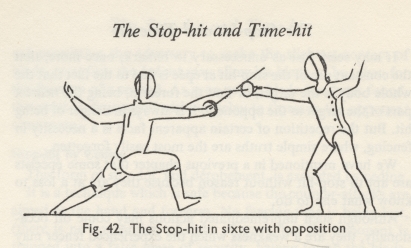
From Crosnier, no explanation necessary.
Fencing with the Epee by Roger Crosnier, 1958. A thorough description of modern classical epee technique, still very useful today. Prof. Crosnier’s book on foil fencing (see the Foil section) should be read hand-in-hand with his epee text.
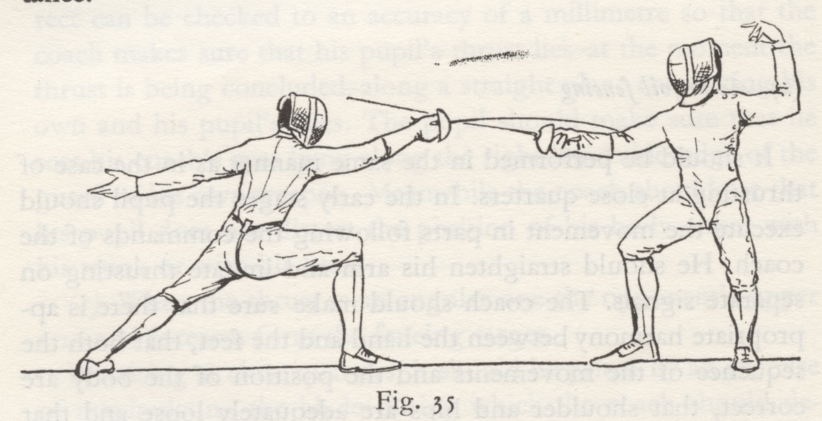
An attack to the arm in the manner of foil, in quarte with opposition. (Does anyone teach foil thrusts in opposition anymore, other than perhaps in sixte? They should.) From Vass.
Epee Fencing: A Complete System by Imre Vass, 1965 in Hungarian, 1976 1st English edition, revised English editions 1998, 2011. The most thorough epee text ever written. That said, highly recommended for epee coaches at all levels, recommended only with caution for intermediate to advanced fencers (at least three to five years or more significant experience)—but not for beginners. There is much useful, often profound, material, but some sections can be skipped entirely by some fencers, and others require sufficient epee fencing experience in order to profit from them. The revised editions were edited by fencer and publisher Stephan Khinoy, and amplify and supplement the original text in places.
The latest edition suggests the need for such classical training today, in spite of the so-called “new paradigm” (see Harmenberg below, his book is also published by Khinoy). I agree; in fact, my fencing master’s thesis (soon finished I hope, albeit delayed by fiction and non-fiction projects, and overwhelmingly by a pre-kindergartner and his younger sister) is based on the same premise. Even for those relatively few fencers (as compared to the entire body of epeeists) who wish to and are able to emulate Harmenberg’s sport methods, a solid base of “modern classical” epee training is still necessary. For most epeeists, even superior amateurs, modern classical technique is all they’ll ever need.
Again, caution is advised when studying the book; it’s best to have a solid understanding of fundamental epee technique and theory before reading it. In fact, it helps to understand the Italian school in order to understand Vass’s theoretical framework: Luigi Barbasetti’s book on foil (see below) is a good start. Vass trained international medalists József Sákovics and Béla Rerrich, both of whom went on to become leading epee masters and national coaches, the former in Hungary, the latter in Sweden, with numerous international champions to their credit. He also trained four-time Olympic gold medalist in epee Győző Kulcsár, who later as a fencing master trained two-time Olympic gold medalist in epee Timea Nagy. József Sákovics, considered by many to be the first “modern” epee fencer, died in 2009, Béla Rerrich in 2005, and Győző Kulcsár in 2018.

La Spada: Metodo del Maestro Caposcuola Giuseppe Mangiarotti by Edoardo Mangiarotti, the Comitato Olimpico Nazionale Italiano, Scuola Centrale Dello Sport, and Federazione Italiana Scherma, 1971. Epee as taught by the famous Guiseppe Mangiarotti: a thorough exposition of his method. Beginner-friendly, too, at least if you read Italian or have a working knowledge of fencing technique and language along with a background in Romance languages other than Italian. Includes excellent illustrations of blade positions, better perhaps than in any other epee text. (Side note: the book even includes illustrations from the works of Vass and Szabo. Kingston and Cheris in this section also have excellent illustrations of blade positions.)
Prof. Mangiarotti, who studied under Italo Santelli as well as under other masters Italian and French, was an Olympic fencer, seventeen-time Italian national epee champion, father of famous champion Edoardo Mangiarotti as well as of noted fencers Dario and Mario Mangiarotti, and founder of a famous epee school in Milan, still in existence, that blended the French and Italian schools and produced champions for decades. Edoardo won 13 Olympic medals and 26 World Championship medals, and was known for his fluid, very Italian footwork as well as for his strategy of attacking hard and fast early on to get touches, then playing a defensive game. Highly recommended: it is my second-favorite “modern” epee fencing book. See also Mangiarotti and Cerchiari in the “Combined Modern Epee, Foil, and Saber Texts” below. For the French school, see Alaux and Cléry in the same section.
Epee Combat Manual by Terence Kingston, 2001, 2004. Highly recommended beginning to intermediate text. Should be required reading for new epeeists. Pair with How to Fence Epee by Schrepfer (below). Unfortunately, Kingston’s book is unavailable in the US anymore, and his web store ships only to the UK and EU (or I suppose he still ships to the EU after Brexit–a lot of small businesses are having issues doing so).
Fencing: Steps to Success by Elaine Cheris, 2002. Actually an epee and foil text, but the epee stands out more to me, and is very useful to both recreational and competitive fencers. Includes training drills as well as excellent illustrations of technique, including from the fencer’s point of view. The book is a good companion to Kingston’s book above. Cheris is one of the great US fencers in both epee and foil.
Epee 2.0: The Birth of the New Paradigm by Johan Harmenberg, 2007. For advanced epeeists and coaches only. There is a second edition–Epee 2.5 I think–that I have not yet read, therefore some or all of the criticisms below might be valid for the new edition. Importantly, the book is suited, in Harmenberg’s own words, only to truly advanced fencers, although this has not stopped many insufficiently experienced epeeists, and even their coaches, from foolishly assuming they can emulate its technique and tactics—and in doing so, impale themselves by repeatedly running onto their adversary’s point from distance much too close. This is often quite funny to watch, especially in the case of exceptionally tall epeeists, with their naturally slower tempo, who throw away their height advantage.
Although there is very useful material in the book, some of Harmenberg’s recommendations are controversial and not all masters agree with the described training regimen, except, again, perhaps in the case of elite epeeists. Further, Harmenberg at times appears to take more credit than he deserves, albeit innocently, given that other epeeists were also knocking at the door of his new style, and had been for some time. Harmenberg, however, was arguably the first elite epeeist to succeed with it at the Olympic and World Championship levels. That is, the first to use “outstripping” attacks—beating the double touch timing by a hair—to the body as a primary technique and tactic, although others, the Soviets notably, had already been using the fleche in renewed attacks to great effect in an outstripping rather than conventional tempo. (Vass calls these sorts of touches “combat” techniques; a better term might be “sport” techniques.) It was also common to see some epeeists below the international level in the 60s and early 70s use technique similar to Harmenberg’s, but they were unable to succeed with it against elite modern classical, aka conventional, epeeists at the international level.
Additionally, some of his criticisms, even though thoroughly honest, of the modern classical technique are not entirely valid. For example, his objection to epeeists who use, and their masters who teach, attacks with a fully extended arm prior to the lunge is somewhat misplaced: although some fencers and masters did adhere to the technique (and some, unbelievably, still do), the lunge with near-simultaneous extension (likewise, “progressive attacks”) was commonplace three or more centuries prior, and also in use again by many masters and fencers beginning a few decades prior to Harmenberg’s era, and some lineages of masters had never taught otherwise. (“Historical” fencers, please don’t bother to argue with me on this smallsword history, simply open up and read the first two dozen period smallsword manuals you lay your hands on.)
Even so, many early epee masters did teach that the attack via lunge, almost always to the arm, must be made with the arm fully extended first, although others argued correctly that simultaneous or near-simultaneous extension and lunge was faster, as Harmenberg likewise deduced (as did masters in past centuries). Indeed, if you intend to hit the body with an attack, you’d better not extend first then lunge! If you do, you’ll lose a tempo, warn your adversary, and probably get successfully parried or counter-attacked. Early epee masters generally avoided recommending attacks to the body due to the increased risk of double touches—and the increased risk of jail time for murder or manslaughter. (Roughly seventy percent of modern epee touches are made to the body thanks to the flat tip of the epee which is less effective to the arm when compared to the old jacket-tearing points d’arret which were highly analogous to the sharp point of a dueling epee.)
The argument remains as to whether Harmenberg’s described techniques and tactics are truly revolutionary, or merely one of the final steps in the evolution of sport epee, in that the “paradigm” takes complete advantage of the 20th to 25th of a second tempo provided by the electrical apparatus, and entirely disregards any consideration of classical tempo so necessary were swords real — sharp, that is, and intended to put holes in an adversary.
Put plainly, the book is Harmenberg’s exposition of how HE fences. Tellingly, whenever I ask elite European fencers and masters about the book, they shrug their shoulders. If they do happen to know who Harmenberg is, their answer is something on the order of, “Well, if it worked for him, good, but there are many other ways to fence epee…” That said, far too many epee teachers in the US have adopted his theory, all too often too early for their students and quite imperfectly, although lately I see this fad–and there are many fads in fencing–fading.
The book is based on the Swedish epeeist’s experiences leading up to his 1977 world championship and 1980 Olympic gold. In other words, however profound the book may be to sport fencing, its author’s ideas were not new in 2007—only their publication was.
Epee Fencing by Steve Paul et al, published by Leon Paul, 2011. A very useful text for the modern competitor. Positive criticisms: thorough and well-illustrated. Negative criticisms: 100% emphasis on epee as pure sport (as opposed to epee as dueling swordplay or martial art modified for sport) and a magazine-style layout (or in imitation of a badly-designed webpage?), including a thin magazine-like cover that will not hold up to much wear.
How to Fence Epee: The Fantastic 4 Method by Clément Schrepfer, 2015. Translated from the original French edition, Faire de l’épée: La méthode des 4 fantastiques, by Brendan Robertson. Not a manual of technique per se, but suggestions on how to use it. A very useful book, with only little to find disagreement with, and mostly in terms of style or tradition and not practicality. Highly recommended, especially for beginning to intermediate epeeists. An excellent companion volume to the Epee Combat Manual by Kingston (above) or Learn Fencing — Épée below.
Learn Fencing — Épée by Peter Russel, 2015. A generally good introduction to modern epee for beginners. Quibbles: the black background and resolution of some of the photos makes for difficult viewing and therefore comprehension at times, and the description of beats is inadequate, essentially relegating the beat to a reconnaissance action with the foible. This may be an artifact of the ignorance of the beat many modern fencers have (I blame their coaches for following the fad of not teaching a complete technique). Numerous times over the past fifteen years I’ve been told by visiting fencers that they’ve never encountered a beat as strong as mine and suggest I must have extraordinary forearm strength. Nonsense! It’s all technique! My wife, smaller and less strong than I am, has a beat as powerful. As Vass (noted above) put it, the beat (use the middle of the blade, not the foible except for reconnaissance) can be used to open the target, delay the adversary’s response, provoke a reaction, and loosen the adversary’s grip, thus further delaying the response. Enough ranting. 🙂 (Last quibble: poor copyediting on the cover, in which Épée is spelled Épeé, but books shouldn’t be judged by their covers.)
See also the “Combined Modern Epee, Foil, and Saber Texts” section, especially Alaux, Barth/Beck, Cléry, de Beaumont, Deladrier, Lidstone, Lukovich, Mangiarotti/Cerchiari, and Vince, as well as the “Epee de Combat” section in general, and Castello and Gravé in the “Classical Fencing” section.
The Epee de Combat or Dueling Sword:
Epee for Actual Combat, In Other Words (and Almost Immediately for Sport as Well)
All of these works are of use to the modern epeeist, and all demonstrate that there is, overall, little new in modern epee fencing. Even the pistol grip was growing in popularity in France by 1908, although its use in dueling was prohibited and it would be the Italians who found in it the perfect replacement for their rapier grip. Only the tactics and techniques of “out-stripping” (of trying to hit a 25th to a 20th of a second before one gets hit), and of the unrealistic abomination of flicking (and arguably, of foot touches), are new. In fact, by 1900, if not earlier, epee was often judged not according to the realities of sharp swords, but according to a perceptible difference in timing when both fencers hit–in other words, who hit first, much akin to the modern electrical apparatus (unfortunately).
Double touches, including “outstripping” touches of which modern epeeists are so fond (hitting just enough prior to the adversary’s hit that it will be considered a single touch, when with real swords both fencers would be hit) have long been the bane of the salle or sport fencer, even long before the advent of electrical scoring and its too short timing–there have always been fencers trying only to get the first hit, however they may, as if playing tag. There is an unfortunate natural tendency to turn fencing into a game of mere “who hits first” tag. As for the flick, it is new only to epee: it was used by a fair number of foilists in the 19th century and almost certainly in the two immediately prior centuries as well. Flicks and foot touches are too dangerous to attempt with an epee de combat: they would cause little damage while leaving the user vulnerable to more damaging, even fatal, thrusts, not to mention that the blade of a real dueling epee is too stiff to permit the flick. Some old dueling epee masters even proscribed the “thrown thrust” common in epee, because, like the flick would if it could be used with a dueling sword (it can’t because the dueling blade is too stiff), it wounded only the skin, not the muscle beneath; the latter wound was more likely to end the contest.
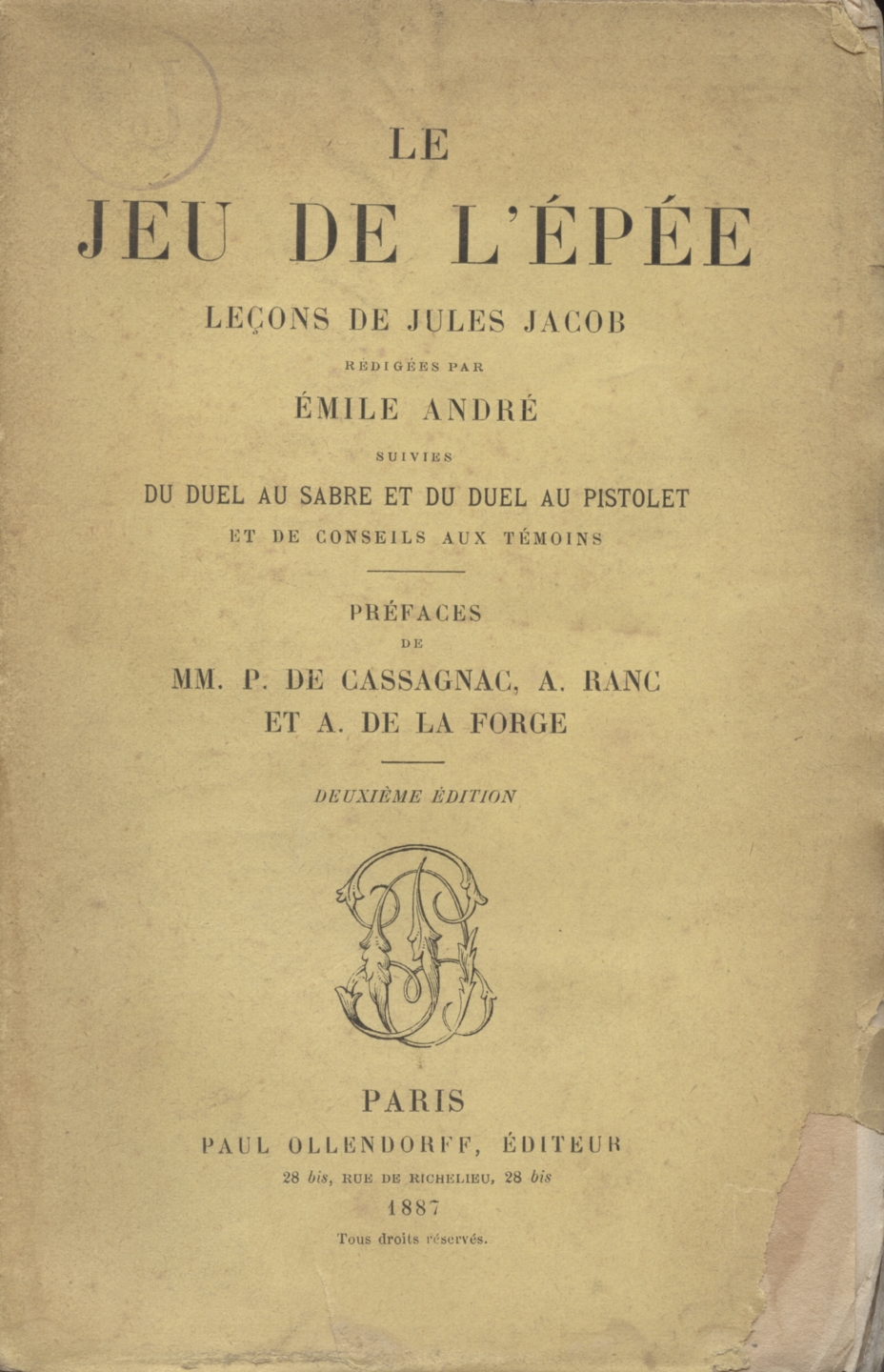
Le jeu de l’épée by Jules Jacob, as reported by Émile André, 1887. Lessons of the fencing master who essentially created modern epee in the 1870s. By the third quarter of the19th century the foil had become a “weapon” of pure sport, although it had been heading in this direction since the late 17th century. M. Jacob adapted smallsword technique to create a form of swordplay suitable to surviving a duel with the 19th century épée de combat, or mere epee, as its modern descendant is called. The technique emphasized longer distance and hits to the arm—and thereby also reduced convictions for manslaughter and murder. It some came to be known as the “modern school,” as opposed to the “traditional school”–foil fencing, that is.
The book outraged many foil purists, who subsequently went into sophistic denial when his epee technique proved far superior to foil technique in a duel: Jacob’s less technically proficient epeeists were deadly against even highly skilled foilists, who maintained that the only difference between the technique of the salle and of the duel was the accompanying mental attitude. (If true, attitude was clearly deficient among the fleurettistes who fought duels with Jacob’s épéistes.) The book plainly points out the difference between the jeu de salle (sport fencing) and the jeu de terrain (swordplay of the duel), and reminds us that many of the best duelists were usually not “forts tireurs”—good sport fencers, that is. The same would doubtless be true today. Highly recommended. There is, I believe, an English translation now available.
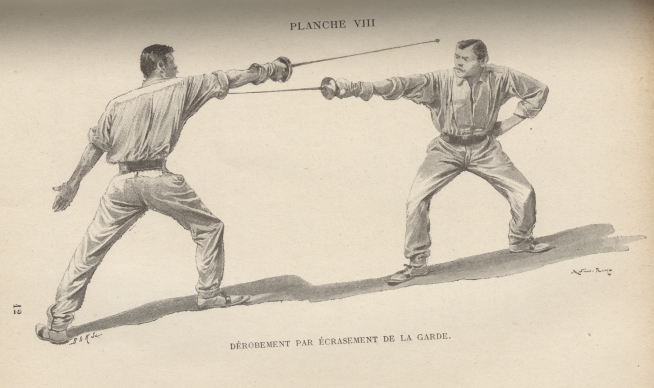
From La Marche. Note the en garde with unarmed hand pressed against the hip, unusual even when the book was published, but La Marche had his reasons.
L’Épée by Claude La Marche [Georges-Marie Felizet], illustrated by Marius Roy, 1884, reprinted 1898 or 1899; also The Dueling Sword, an English translation edited and translated by Brian House, 2010. Very thorough, and in its translation was for a long time the only early French epee and epee dueling manual available in English. Real swordplay, in other words, and useful even to epeeists today. To a degree the book is a somewhat foil-based response to the purely epee-based technique of M. Jacob (see above). M. La Marche differs from M. Jacob on some points, particularly on the value of attacks to the body, of which M. La Marche is in favor, as were smallswords-men (and smallswords-women).
The modern trend in epee, at least at the elite levels, and among instructors who train less skilled fencers as if they were elite fencers, emphasizes attacks to the body. Where to emphasize attacks—arm or body—has been an ongoing re-argument ever since the flat electric tip was introduced to replace the much superior “pineapple” tip in the early 1960s, rendering arm shots more difficult. The epee fencing argument over arm versus body derives from late nineteenth century dueling practice—arms hits could easily settle honor in the modern age in which killing a man in a duel would surely send the perpetrator to prison, and the longer distance that facilitated them was simply safer. For reasons that would take up too much space here in discussion, the body was also the primary target in the smallsword era—but the dangers of this distance were mitigated by the use of the unarmed hand to parry and oppose as necessary, and by the extensive use of opposition and prises de fer. Similar varying perspectives are seen in sport epee today. Notably, and often forgotten by some fencing teachers, roughly thirty percent of epee touches today are to the arm, not the body, even with the emphasis on the body as the better target for the flat modern epee point. A highly recommended book, and useful even to modern competitive epee fencers.
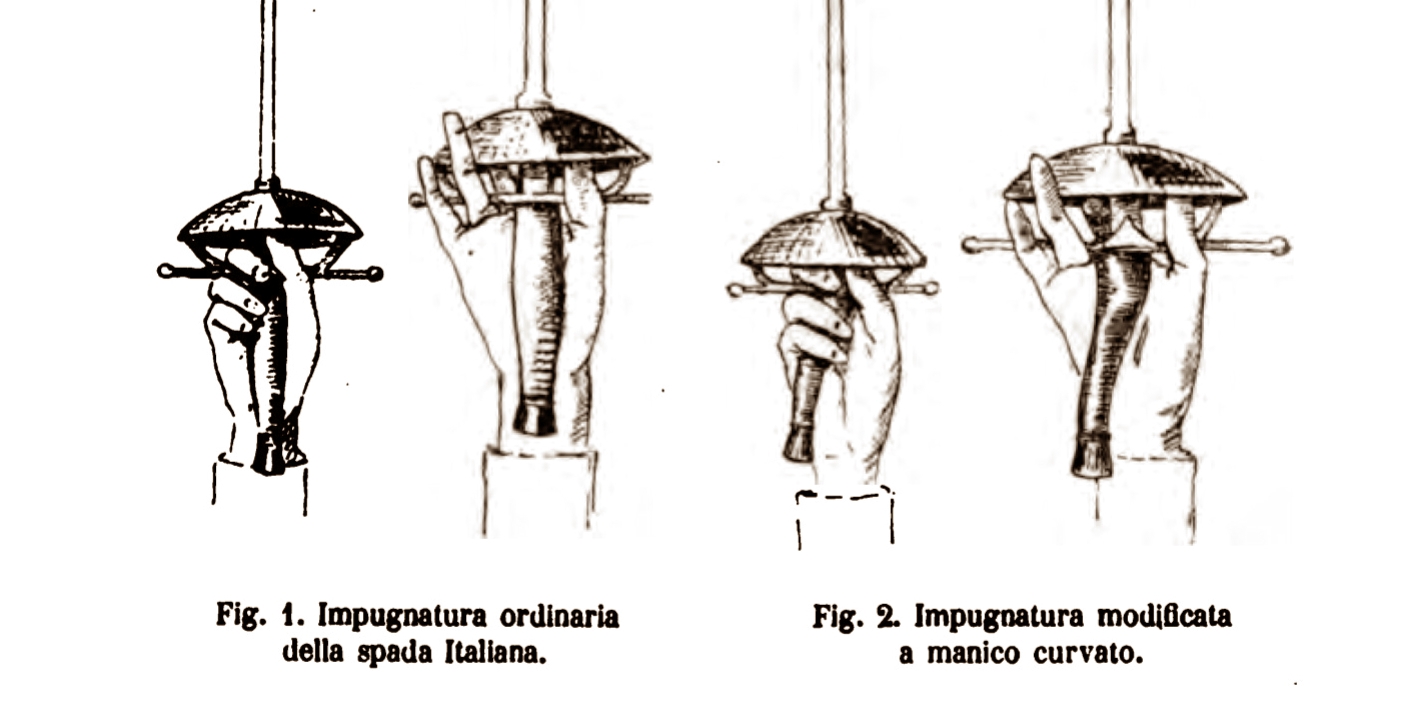
Italian grips and how to hold them, Rossi 1885.
Manuale Teorico-Pratico per la Scherma di Spada e Sciabola by Giordano Rossi, 1885. A manual of the Italian dueling sword and dueling saber, very practical, very classically Italian although it does include some “modern” usages, including a choice of Italian spada with a curved grip, akin to a later French grip, with a significant set to the blade, although it doesn’t seem that this style of Italian grip won many fencers over–but did it perhaps influence the French to increase the curve of their grip? I haven’t seen any French foils or epees circa the 1880s with such a severe curve. The book demonstrates a technique quite useful to epee, and in fact the influence of the Italian school would become a significant part of modern epee.

L’Art du Duel by Adolphe Eugene Tavernier, 1885. Advice on dueling. Suggests tactics and techniques for the epee duel, including how to deal with the inexperienced adversary, the average one and, of course, the expert swordsman. Of interest to the student of fencing history and the duelist, and one of the few books to deal with the subject of tactics against fencers of various levels of competence.

Withdrawing the arm, still used–overused by some, to the point of being considered an en garde position by some masters and their students–today. Useful for preventing hits to the arm and forcing the adversary to attack the body instead, assuming of course the adversary is so impatient as to give in to the tactic. It could also be a dangerous tactic, given the dangers of a successful thrust to the torso. From Spinnewyn.
L’Escrime a l’épée by Anthime Spinnewyn and Paul Manoury, 1898. Excellent work on the epee de combat, with much practical advice on epee fencing, training, and teaching applicable even today. Among the many worthwhile admonitions is that the recovery from the lunge is just as important as the lunge itself–both must be as fast as possible, especially if the epees are pointed.
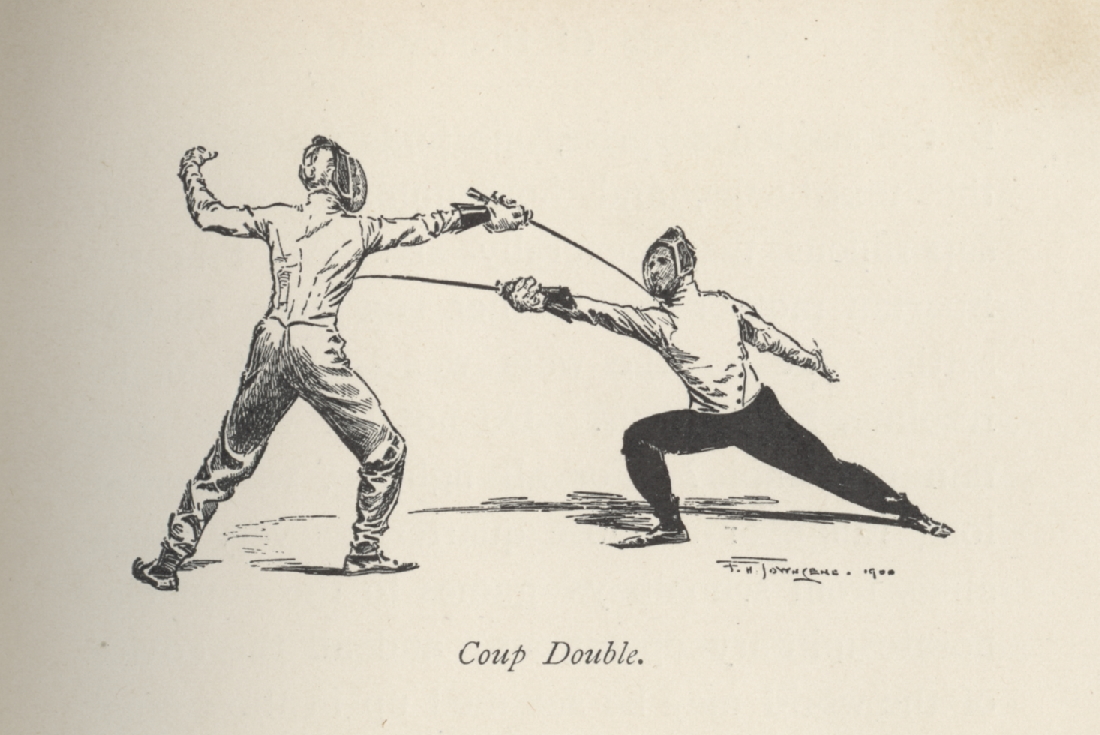
The “coup double” (double touch) as depicted by F. H. Townsend in Secrets of the Sword by the Baron de Bazancourt, 1900 (English translation by C. F. Clay of the original 1862 French edition).
Les secrets de l’épée by Baron César de Bazancourt, 1862, published in English as Secrets of the Sword in 1900, reprint 1998. Practical advice on hitting and not getting hit from the mid-19th century. Much of the advice sounds quite modern. Likewise highly recommended.

Seconde parry against a direct thrust. The seconde parry, as with all low line parries in epee, may be effectively used in the high lines as well. From Edom.
L’escrime, le duel & l’épée by Achille Edom, 1908. A remarkably prescient and practical work, one of my favorites, and one that demonstrates plainly that there is little new in epee fencing today. In particular, M. Edom, a Frenchman, recommends the more physical Italian style over the French, prefers the Greco offset guard and the pistol grip, and bemoans the rise of sport technique such as wide angulations to the wrist—thrusts that with dueling epees (with sharp points, that is) would not stop a fully developed attack to the body, leaving the attacker with a wound to the wrist, and the attacked with a possibly fatal wound to the chest, neck, or head.
The origin of these angulations was due much in part to the single point type of point d’arrét used by many at the time: a small ring was soldered to a real pointed blade a centimeter or so from the tip, then wrapped with heavy thread to act as a barrier to full penetration. Unfortunately, this heavy wrapping prevented hits at the shallow angles a real point was capable of, thus a new emphasis on unrealistic wide angulations. The three point “dry” and four point electrical, and later “pineapple” electrical points d’arrét greatly corrected this, but the subsequent modern flat point (brought into use in the early 1960s in order to quit tearing up the new nylon jackets perhaps?) inspired the popularity of severe angulations once more. In fact, almost any stop thrust to the arm would not arrest a fully developed attack, although you might have the satisfaction, as your adversary’s attacking blade penetrates your chest, of pinning his (or her) arm to his (or her) chest as he (or she) runs up your blade. Highly recommended.
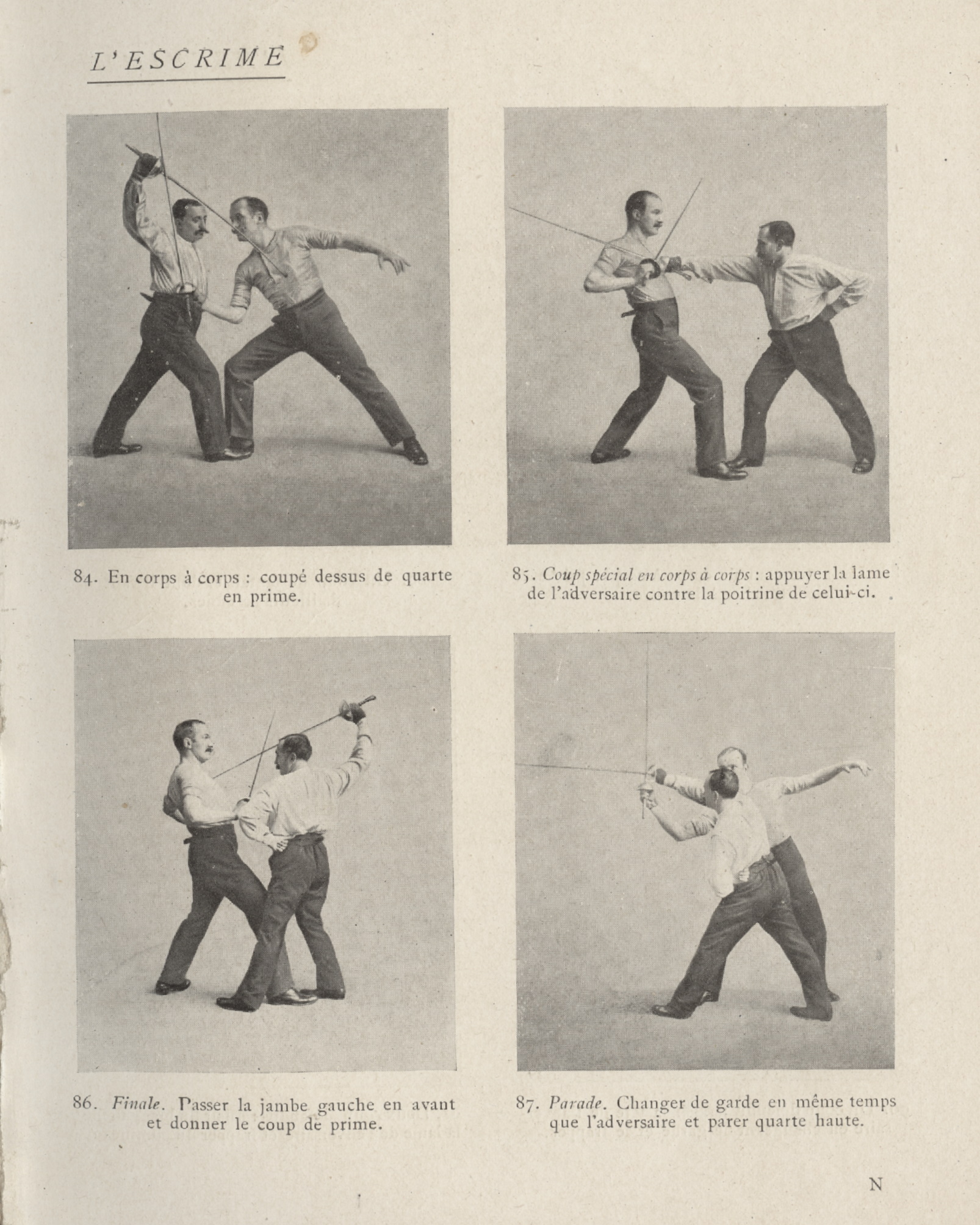
Close combat, as depicted by J. Joseph Renaud. In practice, the directeur de combat would halt the duel prior to such potentially deadly antics. Even so, the circumstance could arise and the duelist must be prepared. Side note: for decades the term for fencing referee in the US was directeur de combat, taken from dueling. It was changed within my fencing lifetime to referee in order to, literally and nonsensically, “make fencing easier for the audience to understand.”
L’Escrime by J. Joseph-Renaud, 1911. One of the best of a number of outstanding epee books published during the Golden Age of epee and of books on the subject, by far. The author does by far a superior job explaining the faults in French foil for dueling, comparing French foil to Italian (thus explaining why Italians successfully trained with their foil for the duel with the spada or epee de combat but the same could not be said of the French), and explaining a wide variety of epee technique, both that which is correct and that which is faulty but commonly seen. Thoroughly illustrated with photographs, the volume is of great use to the modern epeeist, historical or classical epeeist, and fencing historian and theorist. Joseph-Renaud is a member of the community of epee masters for whom the lunge must always be preceded by a fully extended arm, and he does not recommend attacks to the body. Much of the reasoning for this is to protect the duelist from a potentially mortal wound in himself or in his adversary, the latter of which would result in criminal prosecution and the former of which, well… In fact, as smallswords-men of past centuries, and even the author himself, knew, the lunge with the arm extending near simultaneously (just a hair ahead, that is) is the fastest attack by lunge, and mandatory if one is attacking the body, not the arm.
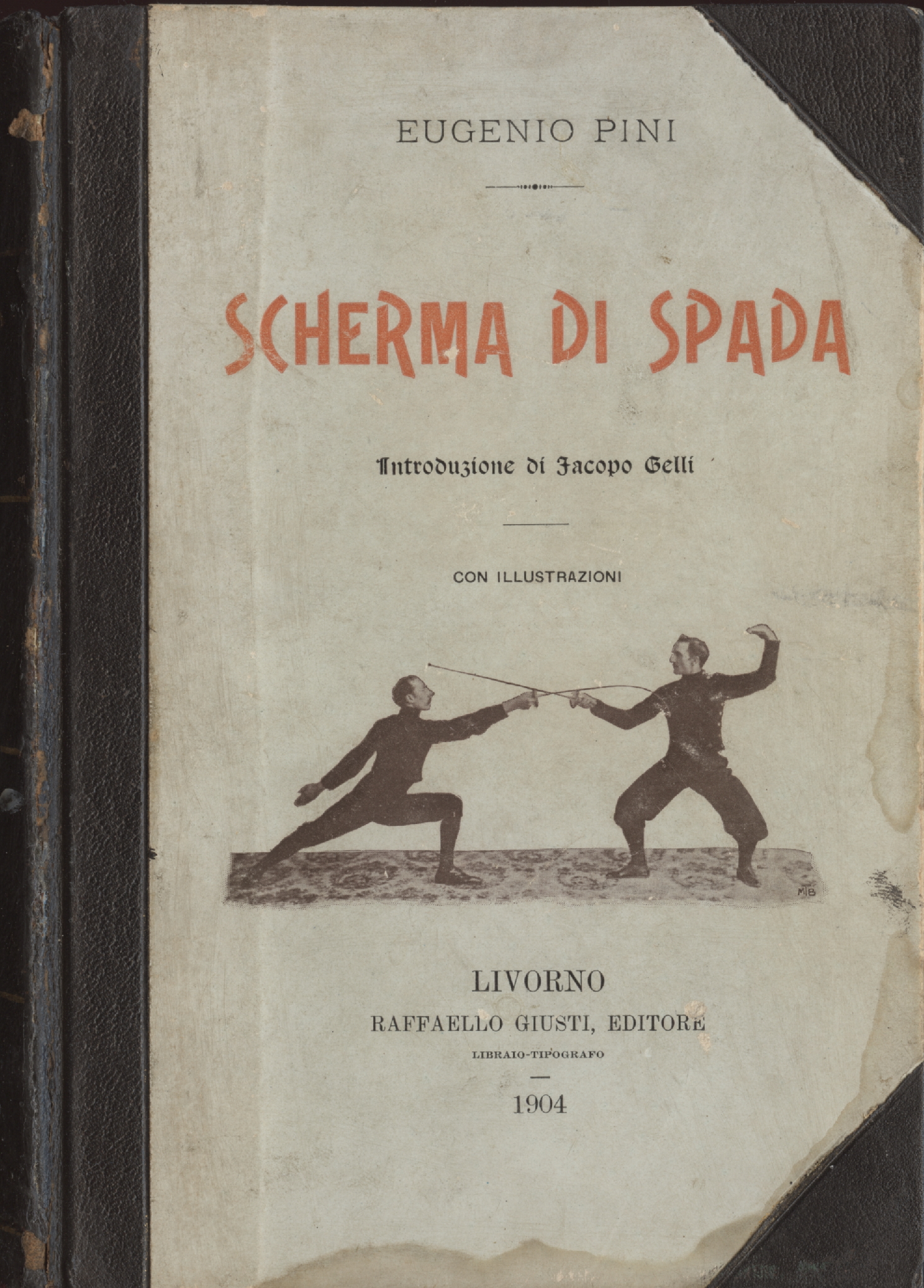
Tratto Pratico e Teorico Sulla Scherma di Spada, by Eugenio Pini, 1904. Excellent and thorough practical treatise on swordplay with the Italian spada or dueling sword by the Italian master who epitomized a form of swordplay that emphasized physical strength and speed–no, this emphasis isn’t new to fencing, nothing really is, in fact. At the time the book was written, the school of the Italian dueling sword was based on the fioretta or foil, which was used for training instead of the spada itself. Pini points out correctly that at the time the French schools had separated foil from epee, and epeeists were now taught with the epee rather than the foil, although this would soon change as French foilists, unhappy at being usurped by the “modern school” of epee and its epeeists, would attempt to reassert their dominance via a foil-based school of epee. For a long time the Hungarian school, via the Italian, kept up this tradition of training epeeists first as good foilists. In fact, it’s how I was trained more than forty years ago. However, the modern divergence between foil and epee has made this almost impossible.
The Sentiment of the Sword: A Country-house Dialogue by explorer, adventurer, linguist, scholar, writer, and swordsman Sir Richard Burton, 1911. As with Bazancourt’s book which inspired this Anglo version, not strictly an epee manual, but still useful for understanding swordplay in the sense of the need to hit and not get hit, as opposed to hitting according to conventions which deny touches not made in accordance with said conventions, but which in a duel would be quite real, and in many cases fatal. (Thus the practical and, if in a duel, fatal flaw in foil fencing.) Burton’s book also has some quite modern advice on learning to fence. Burton had used a real sword many times in bloody combat, and was known as an extraordinarily fierce warrior. Highly recommended.

Filo (bind thrust) riposte to the face after a tierce parry. The face as a riposte target (it’s much easier to hit than the shoulder), or even as a counter-attack target (it’s unexpected), is sadly undervalued by many modern epeeists. From Greco’s book.
La Spada e la Sua Disciplina d’Arte by Agesilao Greco, 1912. Another of my favorites: a practical, very Italian text on the dueling sword, with, among other things, demonstrations of the Italian grip versus the French (e.g. showing that opposition with the Italian grip can overcome the extra length afforded by holding the French grip toward the pommel) and, a rarity in epee books, French especially, numerous bind thrusts to the head (filo al viso; in fairness to the French, Joseph Renaud describes and illustrates a stop thrust au visage with esquive). Greco advocates four parries: prime (a sixte taken with an extended arm), tierce, quarte, and seconde.
The text also includes many examples of filo thrusts (bind thrusts, strong opposition thrusts) to the torso, which are often downplayed in French texts of the era, given the possibility of killing one’s adversary with them (better to hit the arm a few times and go home than worry through an investigation and possible conviction for manslaughter or murder; some period French texts do discuss these thrusts, particularly those of the “foil-epee” and “foil” French dueling schools). The book also includes descriptions of the Italian spada (noting that at the time they were of equal length, i.e. the Italian had a slightly longer blade), clothing and equipment, &c. The photographs are clear and well-posed. Unbelievably, my copy, signed, was never read: most of the pages are still uncut. Highly recommended.
Agesilao Greco was, along with his brother Aurelio, the greatest of a great family of fencers dating to the mid-19th century. The brothers highly influenced the Italian form of epee fencing for both dueling and sport. The Greco Academy of Arms in Rome still exists and still trains world class fencers. It also has a nationally-recognized fencing museum, the Casa Museo Accademia d’Armi Musumeci Greco that I’ve been told is well worth visiting. Greco’s description of the dueling spada is as elegant as the sword is; I’ve included it here and here.
Épée, par J.-Joseph Renaud, 1913, in L’Escrime: fleuret, par Kirchoffer; épée, par J. Joseph Renaud; sabre, par Léon Lécuyer. Excellent advice on training, competition, and dueling, including a technical argument and diagram describing when to use sixte and its counter, and when to use quarte. This latter matter is more important than it seems, for most fencing instructors teach the usual parries and imply that any of the two classical French parries can be used in their appropriate quadrants in any circumstances (true in theory but not in practice) and should be varied in order to keep the adversary guessing (true in both theory and practice, but often difficult given that most fencers under stress have a preferred parry).
There are instances in which only a single parry—even in epee and smallsword, in which low line parries may be used in the high line as well, often providing several possibilities in each quadrant—is viable. For example, quinte (low quarte) against a powerful wide-angled attack, especially if directed toward the abdomen. Any other parry will often be forced or will fail to defeat the angulation. In fact, this is why the quinte parry was introduced. Or, against a wide, high, powerful, angulated thrust to the body in the high outside line (same handed epeeists), in particular when delivered via flèche by a tall strong fencer with his hand in tierce, a circle-sixte or even a circle-tierce will likely be forced even if timed well. A true prime will not defeat the angulation, and a common septime (Italian prime, mezocierco) must be taken too far out of line, exposing the arm to a simple disengage over the top. Octave and seconde cannot be taken effectively, for they too are likely to be forced. Only quarte or quinte (really just a low quarte) taken with the point out of line, with a riposte to the head or possibly the neck or shoulder, is viable in most cases. A modified prime (high sixte/septime) can work but can be difficult to execute if the attacker is tall and strong. Best to stop such attacks on their preparation.
The book includes a discussion of the Italian school. Although M. Renaud grudgingly admits that Italian foilists are equal to their French counterparts, he disparages Italian epee and by implication its rapier origins, stating categorically that the French invented epee fencing and the Italians were no match for French epeeists. In fact, the Italian epee school would soon rise to equal prominence with the French, with Edoardo Mangiarotti becoming one of the great epeeists of the 20th century. (These include Frenchman Lucien Gaudin of the early 20th century, Hungarians József Sákovics and Győző Kulcsár of the mid- and late century. Johan Harmenberg (1976 – 1980) should probably make the list as well. Were I to include possible twenty-first century epee greats as well, I’d suggest Timea Nagy and Géza Imre of Hungary, and Laura Flessel-Colovic of France. Doubtless other epeeists could join this list.)
Naturally, M. Renaud avoids any discussion of what might happen were French epeeists to trade their epees for Italian dueling spadas. Compare his comments on the Italian school to those of Achille Edom above. Side bar: he notes that most French epee schools of the era had outside gardens for practice, in addition to the indoor salle. Pity we don’t have these today…
“Technique du Duel en Une Leçon Suivi des Règles usuelles du Combat à l’épée” by Georges Dubois, published in La Culture Physique, 1908. Excellent work based on the author’s experience preparing would-be duelists for the duel, including those who have never held a weapon before. Disposes with many myths regarding dueling: he points out that most duelists weren’t fencers, and suggests that the epee was designed to help keep both combatants alive and thereby avoid the charge of manslaughter or murder. Never was a weapon so well designed to keep adversaries from killing each other, the author notes.
See also the “Classical Fencing” section below.
Combined Modern Epee, Foil, and Saber Texts
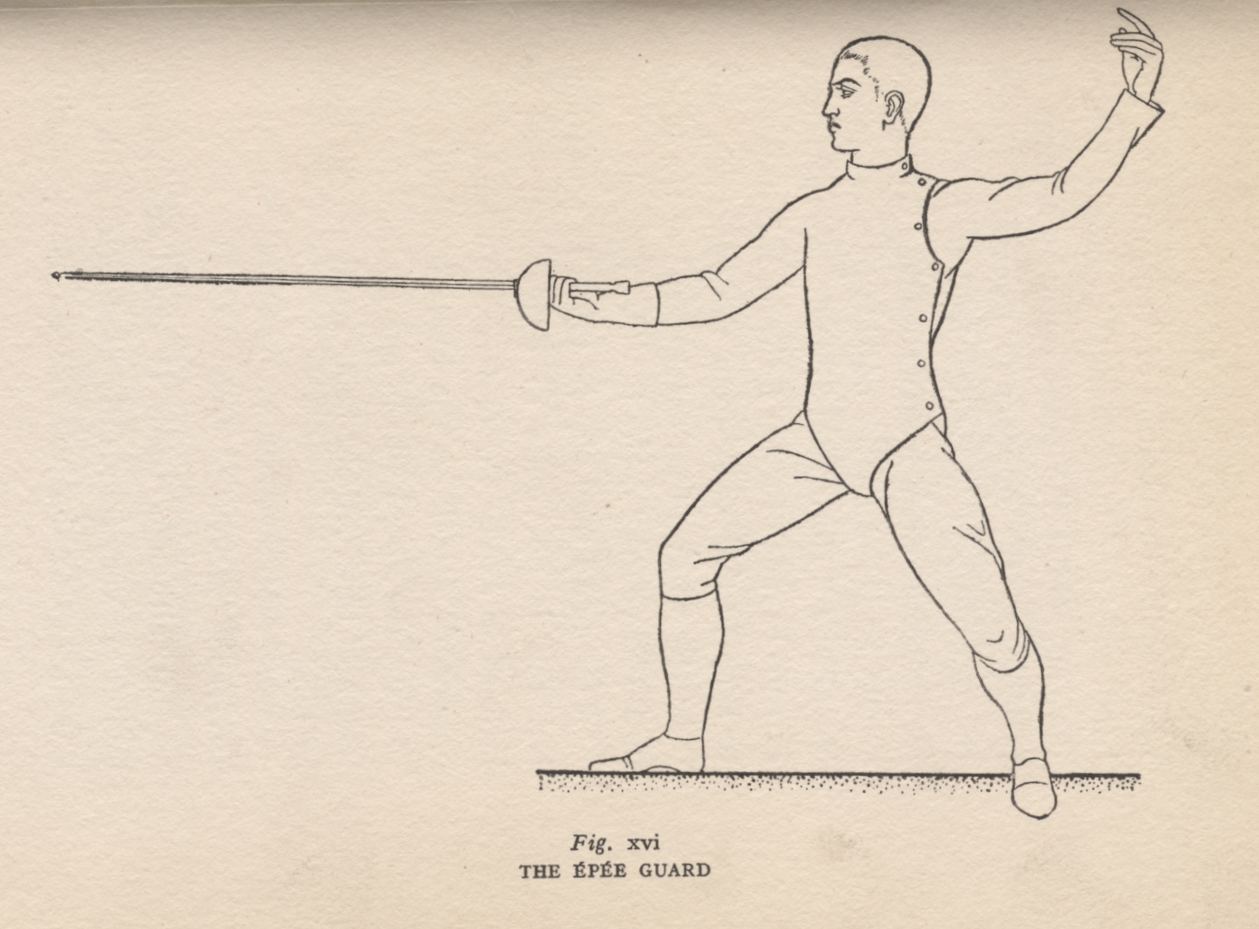
Lidstone, 1930.
The Art of Fencing by R. A. Lidstone, 1930 and Fencing: A Practical Treatise on Foil, Épée, Sabre by R. A. Lidstone, 1952. The second significantly revised book is more thorough, with a very useful, clearly written epee section with plenty of exercises for master and pupil. Discusses tactics, unusual epee en gardes, and, in the foil section, unusual displacements, most of them Italian. It even describes Professor Guissepe Mangiarotti’s “jump back”—an epee counter-attack made while leaping back and landing on the front foot. The second edition is an excellent practical work drawing from both the French and Italian, highly recommended. In fact, along with Szabo’s work, one of the most useful books on fencing on this entire page. For fencing historians, a comparison of the first edition to the second edition shows how much, and how quickly, modern fencing changed during the first half of the twentieth century.
Fencing by Joseph Vince, 1937, 1940, revised edition 1962. Illustrated by US saber champion, designated Olympic team member (until he suddenly abandoned competitive fencing for the stage), and swashbuckling actor Cornel Wilde. Vince was a US national coach and national saber champion who kept a salle in Beverly Hills for decades, and, until 1968 when he sold it to Torao Mori, owned Joseph Vince Company, a fencing equipment supplier that provided, among its complete line, classically dashing fencing jackets of a fit and style unfortunately no longer seen. In fact, my first fencing jacket was a “Joseph Vince, Beverly Hills” made of a heavy, high thread count cotton with silver-colored buttons. The left, that is, unarmed, sleeve was lighter and cuffed. An elegant style truly to be found no more.
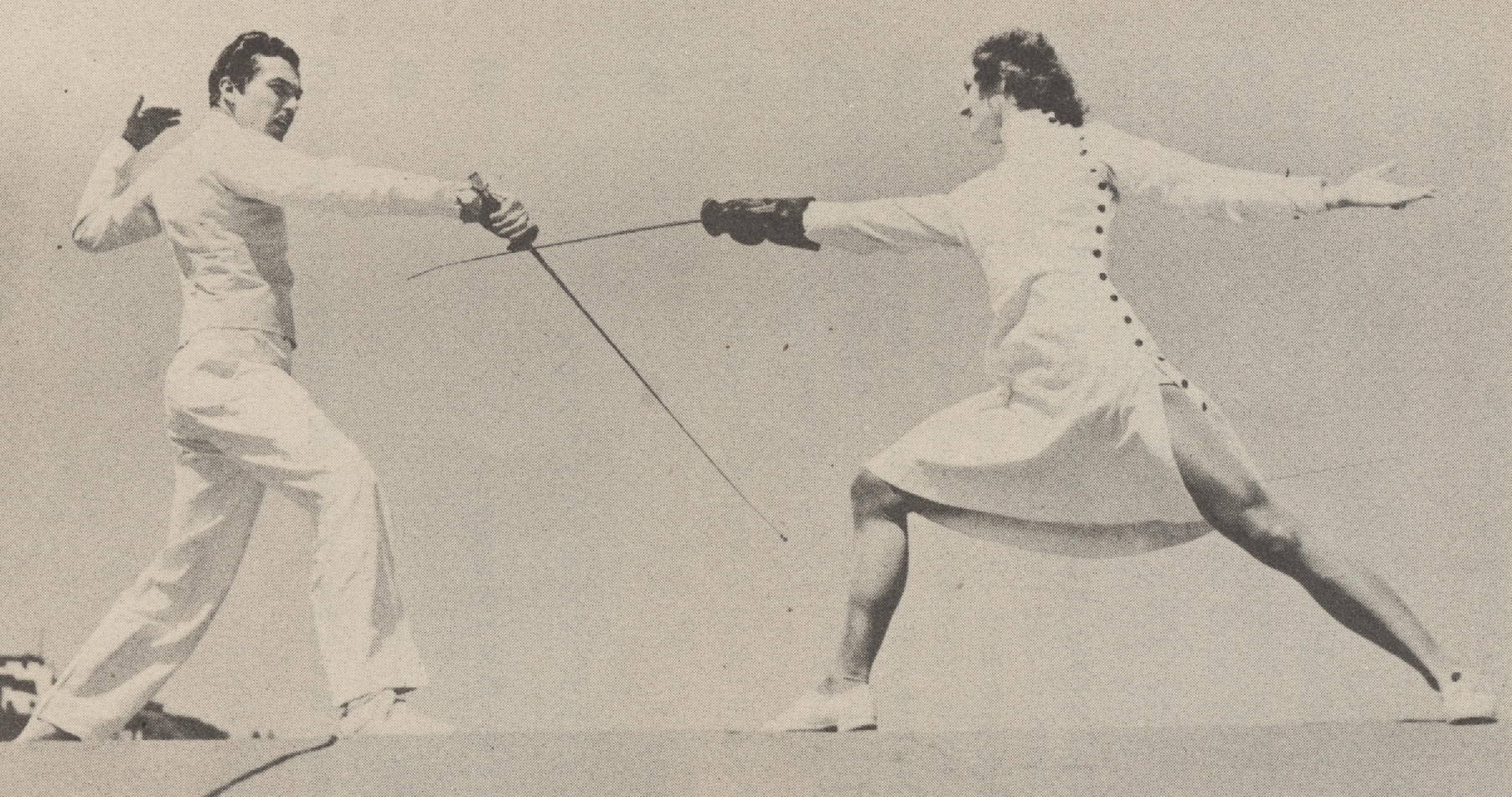
Lunging in women’s fencing dress–quite literally–in Lawson’s book.
Fencing for All by Victor E. Lawson, 1946. The front cover gives the title as How to Fence. A very short basic text, only slightly more than a pamphlet, notable only to the fencing historian, particularly him or her interested in the history of women’s fencing. Lawson’s book actively promotes women fencers, although most appear to be aspiring actresses and models, and the caption of one photograph strongly suggests that Lawson’s goal is to promote his fencing salle in NYC as a means of attaining poise &c for actresses (I use the now generally discarded feminine of “actor” here because “female actor” sounds a bit stilted, and in Lawson’s day he appears to have been recruiting women primarily, not men). Notwithstanding his purpose, Lawson’s little book does actively promote women fencers, and has several useful photographs of women in fencing attire of the 1940s, quite different from today. It also has a good summary of fencing rules at the time. Other titles in the series include Police Jiu Jutsu, Scientific Boxing, and How to Be a Detective–everything to to prepare the reader to be the dark sword of a film noir.
Modern Fencing: A Comprehensive Manual for The Foil—The Epee—The Sabre by Clovis Deladrier, 1948, reprint 2005. Strong epee section. Includes exercises, lesson plans, and excellent practical advice. Readers should not be put off by some terms and practices that seem dated, for example Deladrier’s use of the classic older terms low quarte for septime and low sixte for octave, and his preference for the center-mount epee guard. The epee section is worth serious study. The teaching advice and lesson plans for advanced epeeists called upon to teach at times is also a useful review for experienced epee coaches. Deladrier was the fencing master at the US Naval Academy.
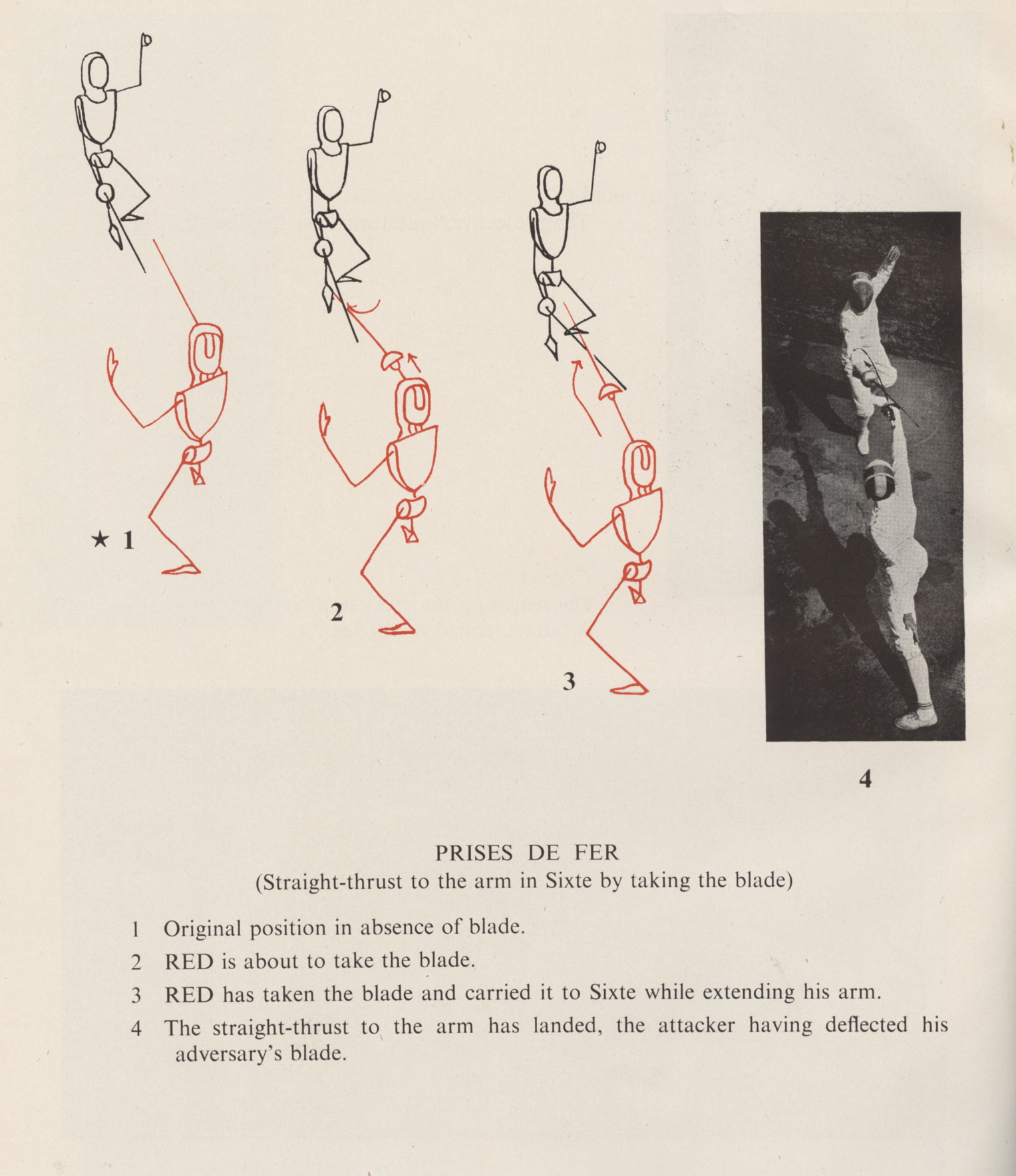
“Prises de Fer” from Fencing Technique in Pictures.
Fencing Technique in Pictures, 1955, edited by C-L. de Beaumont, assisted by Roger Crosnier, with contributors Léon Bertrand, Bela Balogh, and Raymond Paul. Basic foil, epee, and saber instruction by a who’s who of UK fencing masters of the past century, in line drawings and photographs, the former of which look a bit like the robots in the old comic book, Magnus, Robot Killer. Useful information, still applicable today. The book is one of three on this page attempting to show action in sequence in more than two or three steps using photographs or illustrations, the other two being Bertrand and Anderson. I suspect the format of the images and size and color of the book may have influenced Bac Tau’s excellent edition (see below) which in some ways might be an homage. “Dedicated by permission to The Rt. Hon. Sir WINSTON CHURCHILL K. G., O. M., C. H., M. P. First Honorary President of The Amateur Fencing Association.”
Fencing: Ancient Art and Modern Sport by C-L de Beaumont, 1960, 1970, revised edition 1978. Solid “classical” text on electric foil and epee, and dry saber by a noted British master and Olympic fencer. Excellent, perhaps best anywhere, description of the character and characteristics of epee fencing (de Beaumont was an epeeist). Good chapters on tactics and training.

Epee points. The “pineapple” tip, an electrical intermediary between the bottom left and (modern) right, is missing. From Cléry.
Escrime by Raoul Cléry, 1965. A thorough, practical text, absolutely one of the best, by one of the great French masters. Highly recommended. The epitome of the French school in foil and epee, but the saber is Hungarian and is so noted.

Athleticism in epee roughly half a century ago, hardly a new thing. From Mangiarrotti.
La Vera Scherma by Edoardo Mangiarotti and Aldo Cerchiari, 1966. A very useful book for all three weapons, although I’m naturally more disposed to its epee section, particularly given Mangiarotti’s fame in the spada. Exceptionally well-illustrated. In Italian, and the modern classical Italian school, of course. An excellent beginning to intermediate text on all three weapons. One of the virtues of this book are photographs of technique in action, showing what fencing actions actually look like as performed by elite fencers. Most fencing books use posed photographs or otherwise idealistic illustrations, providing elevated expectations of the often unattainable except at slow speed with a conforming partner. There is nothing wrong with illustrating the ideal, providing it is pointed out that it is exactly that, an ideal, seldom to be seen in practice even by elite fencers. The book also includes line drawings of ideal technique.
Modern Fencing: Foil, Epee, and Saber by Michel Alaux, 1975. A thorough introduction to all three weapons by one of the great French masters who taught in the US. Short but good sections on bouting tactics, lessons, and conditioning. Excellent beginning text for the novice fencer. The French school, of course.
Fencing: The Modern International Style by Istvan Lukovich, 1975, 1986. By the author of the noted Electric Foil Fencing. Excellent if brief epee section, very useful to both epeeists and their teachers in that it covers and explains most of what most epeeists will ever need to know. The Hungarian school. Highly recommended for all three weapons.
L’Escrime by Jacques Donnadieu, Christian Noël, and Jean-Marie Safra, 1978. Solid introductory to intermediate text, quite well-illustrated with many photographs of fencing technique, including of technique in competitive action. I’m also somewhat partial to the book given that its images, taken as they were at the time I began fencing, are nostalgic.
Fencing: Techniques of Foil, Epee and Sabre by Brian Pitman, 1988. Solid beginning to intermediate text.
Fencing by Bac H. Tau, 1994[?]. Includes thorough sections on training, tactics, and weapon repair. Excellent section on physical training for fencing, along with other highly useful appendices. Deserves far more attention than it has received. Highly recommended. The book size, cover color, design, and illustrations may have been influenced by–in homage to?–Fencing Technique in Pictures, edited by C – L. de Beaumont, 1955.
Foil, Saber, and Épée Fencing by Maxwell R. Garret, Emmanuil G. Kaidanov, and Gil A. Pezza, 1994. A very useful beginning to intermediate text.
Fencing: What a Sportsman Should Know About Technique and Tactics by David A. Tyshler and Gennady D. Tyshler, 1995. Excellent information but an at times poor translation from Russian. Supplement with the Tyshler DVDs (available from many fencing equipment suppliers), or better yet, simply refer to the DVDs. David Tyshler was a Russian master and Olympic and world championship medalist; Gennady Tyshler is a leading Russian master. Quite a few excellent fencing and teaching materials produced by the Tyshler’s are now available online.
The Complete Guide to Fencing, edited by Berndt Barth and Emil Beck, 2007. The German school. A thorough, up-to-date text. Good sections on theory, performance, and athletic training (with a useful emphasis on high rep exercises). Good epee section, much derived from the highly successful Tauberbischofsheim school of epee founded by the largely self-taught Emil Beck.
Modern Foil
The technique described in many of the books in this section is based on the 20th century rule that a foil attack consists either of a fully extended arm with point threatening—aimed at, that is—the valid target, or the later rule which permitted an extending arm with point threatening relaxed, and correctly so, in order to accommodate the highly useful and historically proven progressive attack. These rules—even the original requirement of an extended arm before the lunge, which is not ideal in combat— were rooted in dueling practice and therefore made more sense than the modern interpretation of an attack which is, frankly, often indecipherable and which under the original conventions of attack, not to mention in engagements with “sharps,” would be easily invalidated by a counter-attack. In other words, an attack should not consist of a bent, non-extending arm at any point, especially one with the point aimed at something other than the valid target. Attacks in invitation or otherwise with a bent non-extending arm are quite simply not in the spirit of staying alive. In other words, were the swords pointed, the modern attack would be simply suicidal. Unfortunately, right-of-way in foil and saber have abandoned this principal, permitting attacks with a bent-arm and the point well out-of-line. Put more simply, fence epee until foil and saber are fixed—if ever they are.
Fencing with the Foil by Roger Crosnier, 1955. One of the best expositions of modern classical foil of the French school ever written in English. Excellent explanations of practical theory, including on tempo and the progressive attack. Frankly, excellent throughout. Epeeists should read it together with Crosnier’s epee text, foilists together with Lukovich’s foil text.
Foil Fencing by Muriel Bower [Muriel Taitt], 1966 et al. Numerous editions, prefer the latest (1996, Muriel Taitt). Solid beginning foil text, used over the four decades by thousands of beginning fencers, including in 1977 by the compiler of this list of books in a beginning class taught by Dr. Francis Zold. Or at least I think it was this text. Perhaps it was Curry’s instead? The second editon of Bower’s version includes as co-author Torao Mori–a noted competitive fencer and fencing master–who took over the Joseph Vince Co. fencing supplier on Crenshaw Blvd (and where I purchased my first fencing mask, jacket, and glove in 1977).
Fencing by Nancy L. Curry, 1969. Solid beginning foil text although dated in terms of “modern” foil technique and rules. Even so, a good text on core technique. The book is clearly intended to accompany a college-level beginning fencing class and here it succeeds, describing in basic terms the fundamentals that can be covered in a single semester. As with a few other texts, it has useful images of fencing technique taken from above in order to show correct relationships. Nit-picking here: in the acknowledgements, a reference to the famous Castello fencing supplier is written as Costello, a typo and surely not a hat tip to Abbott and Lou…
All About Fencing: An Introduction to the Foil by Bob Anderson, 1970, 2nd printing 1973. The book is unique in that the reader can, by flipping pages, see properly executed technique, and in a manner superior even to much of the modern fencing video available. There is a hint of two of sexism common to the era—Anderson states that only men can cope with the epee and sabre, for example, which is nonsense—, but few fencing books of the first seven or eight decades of the 20th century do not take such a view. Some might disagree with some of his brief fencing history as well, but the history in many fencing books is open for debate, based as it often is on common understanding as opposed to rigorous analysis.
Anderson was a British Olympic fencer and Olympic coach who became Hollywood’s leading swordplay choreographer, following in the footsteps of Fred Cavens and Ralph Faulkner. The fencing in Star Wars, The Princess Bride, and Alatriste are but three of his many film works. (His book is also one of the first two books on fencing the compiler of this list ever read. In fact, the book was in the Mount Miguel HS library—seldom anymore will you find fencing books in high school libraries.) Mr. Anderson died on January 1, 2012, and was inexplicably and inexcusably snubbed by both the 2012 and 2013 Oscars during the In Memoriam segment.
Electric Foil Fencing by Istvan Lukovich, 1971, 1998. Perhaps the most thorough electrical foil text, with excellent sections on fencing theory and requirements. Valuable even today, in spite of being written and published prior to the modern debasement of right-of-way conventions (i.e. attacks in invitation or “bent arm” attacks legitimized), although foil and saber were already inclining in this direction when Lukovich wrote his book.
Foil and The Revised Foil by Charles Selberg, 1975 and 1993 respectively. Thorough and very useful, with a good section on tactics. Highly recommended, but prefer the 1993 Revised Foil. Selberg also produced an extensive selection of instructional videos. Now on DVD, they are available from Selberg Fencing at http://www.selbergfencing.com/.
Basic Foil Fencing by Charles Simonian, 2005. A solid introductory text.
Foil Lessons With Victor by David A. Littell, 1994. A twenty-three page foil monograph far more useful than its brevity might suggest. It’s based on the author’s lessons from fencing master Victor Bukov. Useful in all three weapons, it presents a variety of tactical methods of attack, heavily distance-based. Readers familiar with Hungarian theory and practice (and thereby Russian and general East European) will recognize the descriptions.
“Modern” Saber
Modern Sabre Methodology by Zoltán Beke and József Polgár, 1963. Translated from the Hungarian. Not “modern” in the sense of the most recent form of saber fencing, but “modern” in the sense of twentieth century Hungarian saber before saber’s debasement via the electrical scoring system and the degeneration of the interpretation of right-of-way. Worth acquiring if you can find an affordable copy, but if you do it will likely be by accident, unfortunately. Mine was. A very thorough exposition of every technique in the Hungarian saber repertoire. Not for beginners! One of my favorite passages is its excellent, simple definition of tempo, along with the very useful discussion following, all suitable to all three weapons—or to all swords in all places in all eras, in fact. It is also, from a historical perspective, easy to see how Hungarian saber influenced Hungarian epee, and therefore modern epee.
Fencing With the Saber by Roger Crosnier, 1965. Excellent, thorough work on “Hungarian” saber, second only to that of Beke and Polgár above. A suitable companion to Prof. Crosnier’s works on foil and epee. Note, however, that the terminology and categorization of technique is of the classical French school, not the Hungarian. The fundamentals are still useful today. Naturally, Prof. Crosnier does not permit the attack with the arm in invitation or otherwise bent…
Modern Saber Fencing by Zbigniew Borysiuk, 2009. Only if the modern “weapon” known as electric saber appeals to you. Still, a very good book, and the only thorough one on the subject in print in English. Unintelligible conventions plus attacks with the unextending arm held low in invitation while leaving the body nakedly exposed plus awkwardly cramped footwork plus hitting with the flat of the blade do not saber fencing make. The flat merely chastises: it’s the edge that cuts. The rest is simply too tiresome to debate.
The Cléry and Lukovich titles in the “Epee, Foil, and Saber” section have excellent instruction on Hungarian saber. Cléry also includes some detailed history of the origin of the Hungarian school. The Beck/Barth text includes excellent information on modern post-Hungarian saber. The famous Hungarian saber technique was destroyed principally by the electrification of saber, said by knowledgeable world class fencers and FIE sources to have been a compound decision based on the likelihood that the obvious flaws in electric saber would permit a less strict technique, particularly when aided by a debasement of right-of-way, and would thereby open international saber medals to more than the handful countries with the critical mass of elite saber coaches and sabreurs able to master in-depth the clear, clean technical repertoire of the Hungarian weapon; such technique was mandatory for correct judging.
For half a century Hungary reigned over twentieth century saber, and maintained a strong grip on it even after a number of sabreurs defected during the Melbourne Olympic Games in response to the 1956 Hungarian uprising against the Soviet Union. Recent US gains in modern electrical saber were based in part on the early willingness of US coaches to embrace the new “weapon,” while some of their European counterparts, who had previously excelled in saber, attempted to continue the use of traditional Hungarian technique.
Theory, Teaching, and Training
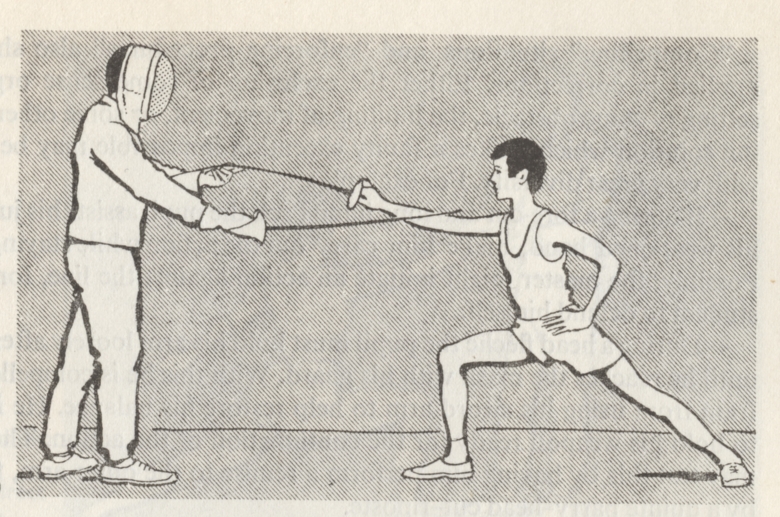
From Szabo.
Fencing and the Master by László Szabó, 1977, 1997. Forward by Dr. Eugene Hamori, a student of Szabó’s (and my second fencing master), in the 1997 edition. The best book ever written on the subject of teaching fencing: the fencing coach’s vade-mecum. Highly recommended. Excellent material on theory and other aspects of fencing, besides the practical. Intermediate to advanced fencers will also find it useful, in particular for its sections on tactics, preparation, drilling, and stealing distance. Szabó, who trained a number of Hungarian champions, was one of Italo Santelli’s three protégés and a close friend of Dr. Francis Zold, my first fencing master.
László Duronelli and Lajos Csiszar were the other two Santelli protégés. Csiszar was master for many years at the University of Pennsylvania after emigrating to the US. Among his students were Dr. Eugene Hamori and Roger Jones, the latter of whom one day contacted me about writing a review of one of my books; during our conversation we realized we had the same ultimate fencing roots and identical views, therefore quite understandably, on honor in fencing. Duronelli was master for many years at the fencing salle at Semmelweis High School, run by Semmelweis University, in Budapest. This delightfully old school salle, which has produced many champions, is still in existence, with László Szepesi, who helped bring saber gold to France, as its current master. Eugene Hamori along with Krisztina Nagy (a very talented fencer and master in both HEMA longsword and modern Olympic saber) escorted my wife and me on a visit to the salle not too long ago.
A Dictionary of Universally Used Fencing Terminology by William M. Gaugler, 1997. A well-researched fencing dictionary although it could have been even longer — but then, only fencing aficionados like myself might read it.
Escrime: Enseignement et entraînement by Daniel Popelin, 2002. In French. The theory and practice of teaching fencing and training fencers. Rather than use the typical pyramidal view of fencing from its base to its competitive elite at the point, M. Popelin suggests a truncated pyramid, whose range is from beginner to national level, to indicate the majority of fencers, and a cylinder on top of this to indicate international and aspiring-to-international fencers. He astutely notes that the majority of fencers do not seriously train to become elite fencers, for many reasons, and thus fencers should be trained differently according to their needs. In other words, the training of the “club” fencer, no matter how talented, should be different from that of the elite competitor. Or put another way, simply because a technique, classical or otherwise, is not used at the elite level is no reason for non-elite competitors to abandon it or, worse, never learn it.
Understanding Fencing by Zbigniew Czajkowski, 2005. Highly recommended for fencers and coaches interested in practical theory. Czajkowski is a leading Polish master whose students in all three weapons have earned gold at the Olympics and world championships.
One Touch at a Time by Aladar Kogler, 2005. The psychology and tactics of competitive fencing, by an Olympic fencing coach and noted sports psychologist. Recommended.
Theory, Methods and Exercises in Fencing by Ziemowit Wojciechowski, circa 1986. By a world-class fencer and master. Foil-based, but still an excellent book for fencers and coaches of all three weapons. Good information on evaluating and dealing with an opponent’s tactical style, especially in foil, although, again, still useful in epee and saber.
See also Joseph Roland, The Amateur of Fencing, in the “Historical Fencing” section below.
“Classical Fencing”
(Modern Non- Electrical Technique)
Some of the books below (Barbasetti, Gaugler) use one of the several classical Italian parrying systems and numberings, as opposed to the French or modified French systems and numbering preferred by most teachers today. (There are also several French-based numbering systems, each differing slightly in the naming of a parry or two, or in the use of a parry, for what it’s worth.) All of the books below are useful to the modern electrical game, epee particularly, and to foil and saber at their fundamental level. At some point foil and saber may return to a more classical standing, rather than their present sport-dominated extreme artificiality, notwithstanding that foil has always been highly artificial, at least for the past 150 to 200 years, and moderately artificial prior to that. Even in the heyday of dueling there was a distinction between “school play” and “fencing with sharps.” See also the texts listed in the “Epee de Combat” section.
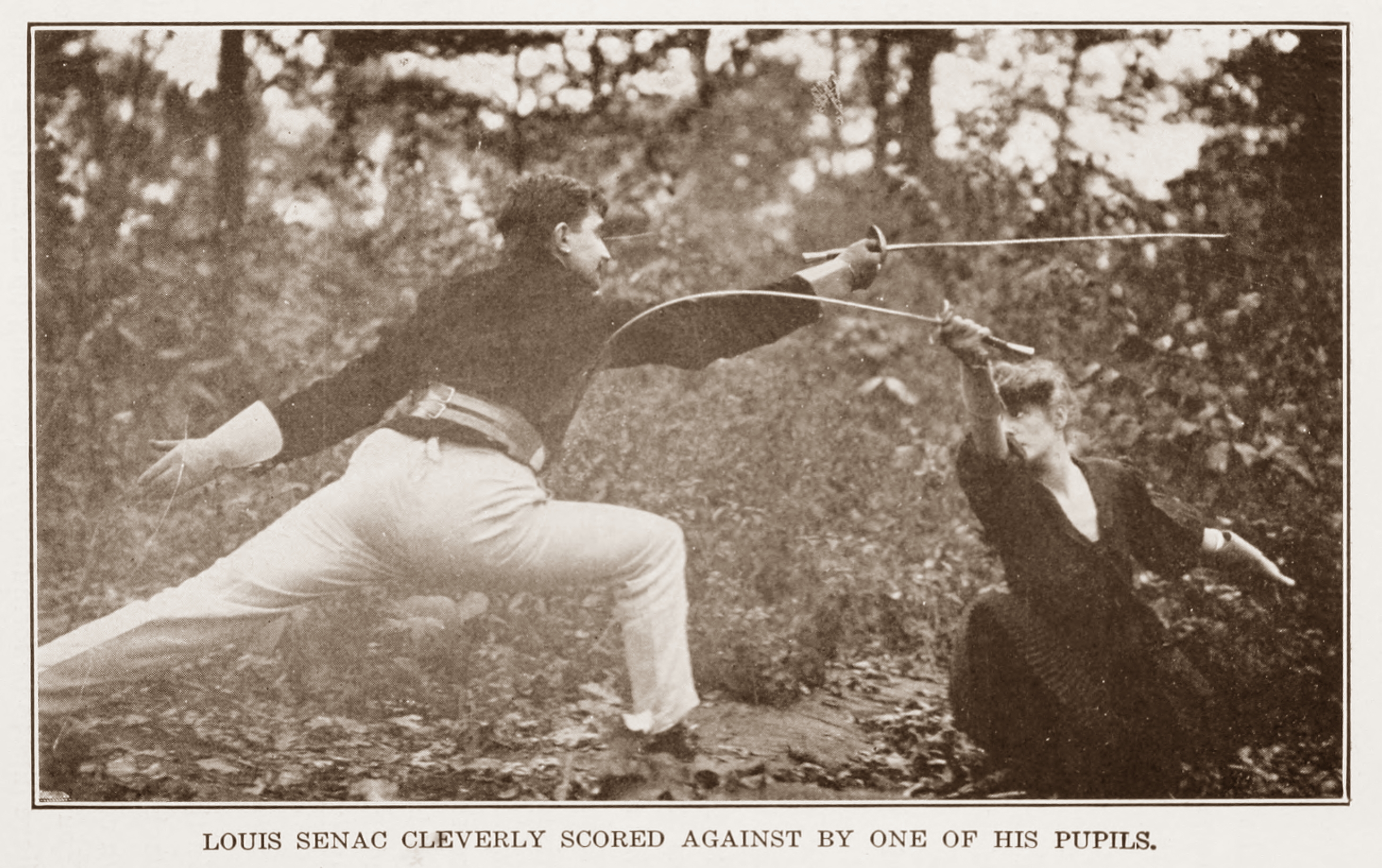
At the right, a beautifully executed (or more likely posed) lunge inward off the line: the Italian intagliata although it is not so-named in the book. Odd that a book that extols the French school so much would demonstrate a technique considered largely Italian at the time. From The Art of Foil by Louis and Regis Senac.
The Art of Fencing by Louis and Regis Senac, with a section on saber by Edward Breck, 1904 (hardcover), also 1915 & 1936 (softcovers, with foil and saber by Breck). Part of the Spalding Athletic Library, the book is particularly useful to fencing historians as it covers a transition period in modern fencing, has illustrations of clearly expert women fencers (unfortunately unidentified), has lengthy fencing equipment adds (1905), shorter equipment ads (1915), and the 1905 Amateur Fencing League of America fencing competition rules (1915, 1936). The book’s downside–but only occasional–is its excessively evangelical attitude in promoting the French school, an attidtude associated with patronizing and common-at-the-time claims that one must be an overly-muscular athlete to fence well in the “inferior” Italian school. Blame the psychological reaction of inferiority by spindly and otherwise unathletic French fencers to the hyper-muscular Italian swordsman Eugenio Pini for this. One can also be lean and still very strong, as with the whipcord muscles of some of Rafael Sabatini’s heroes, a physical type well-suited to fencing and found in reality as often as in fiction. To my mind, there is no excuse, other than long-term injury or disease, not to be fit: with strong muscles, good flexibility, and excellent aerobic and anaerobic endurance. Although the book nobly promotes women’s fencing and notes that at least one woman fencer was more than a match for any man, it does recommend fencing to women in part because it “reduces surplus adipose tissue, making their figures trim and comely, rounds their muscles, develops their busts,” &c. Perhaps this was mere marketing and not sincerely-held chauvinism.
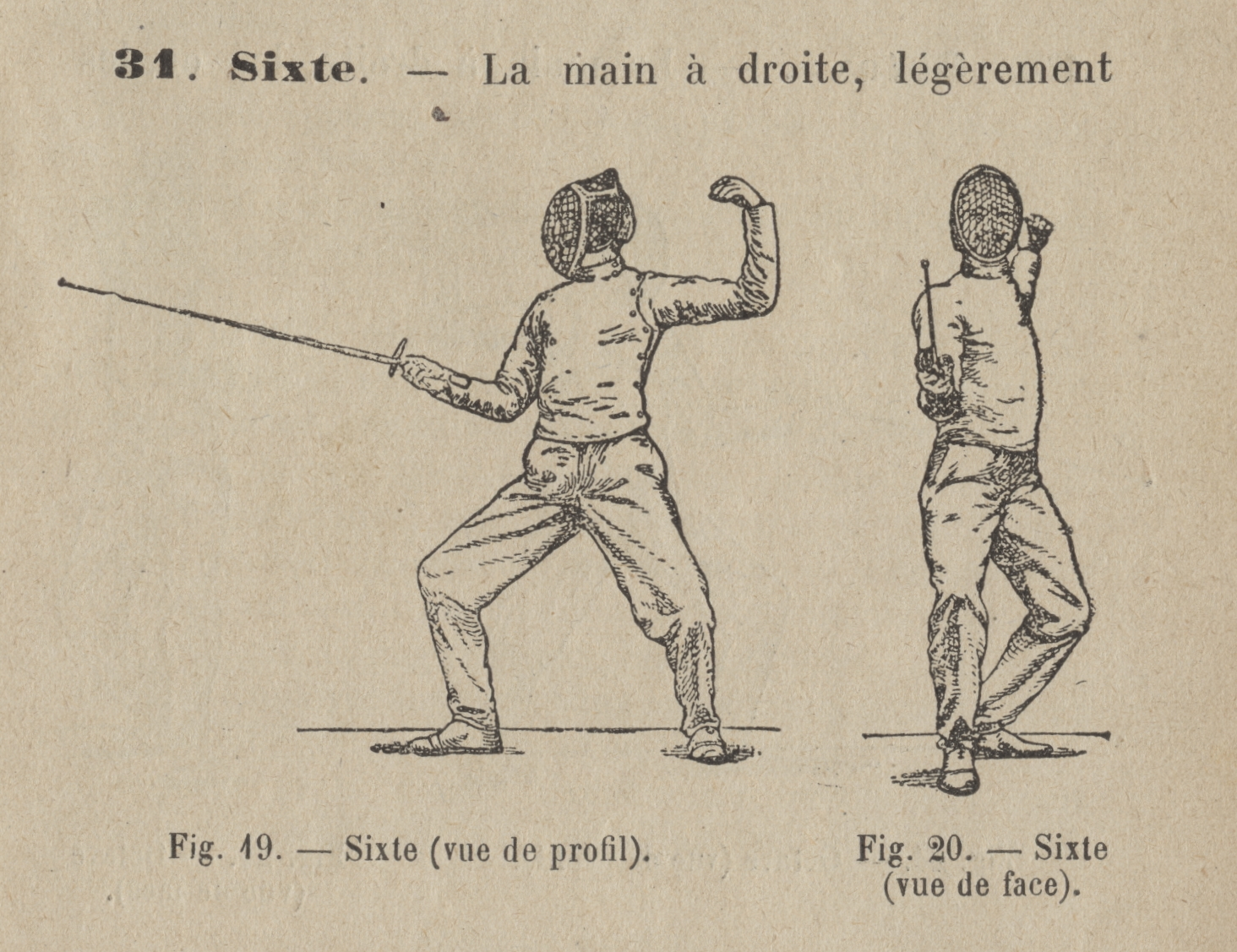
Sixte en garde from the Réglement d’Escrime.
Réglement d’Escrime by the Ministère de la Guerre, France, 1909 and other editions. A short treatise on foil fencing for the French military that provides a detailed look at the classical French school. Useful for classical fencers and historians, and, frankly, any fencers interested in French technique given that it remains sound today, at least as a foundation. Oddly, one would have expected the French military to have adopted the new epee technique rather than foil at this time, and even more so, would have emphasised the saber instead of either, given that it was still in use as a practical military arm at the time.
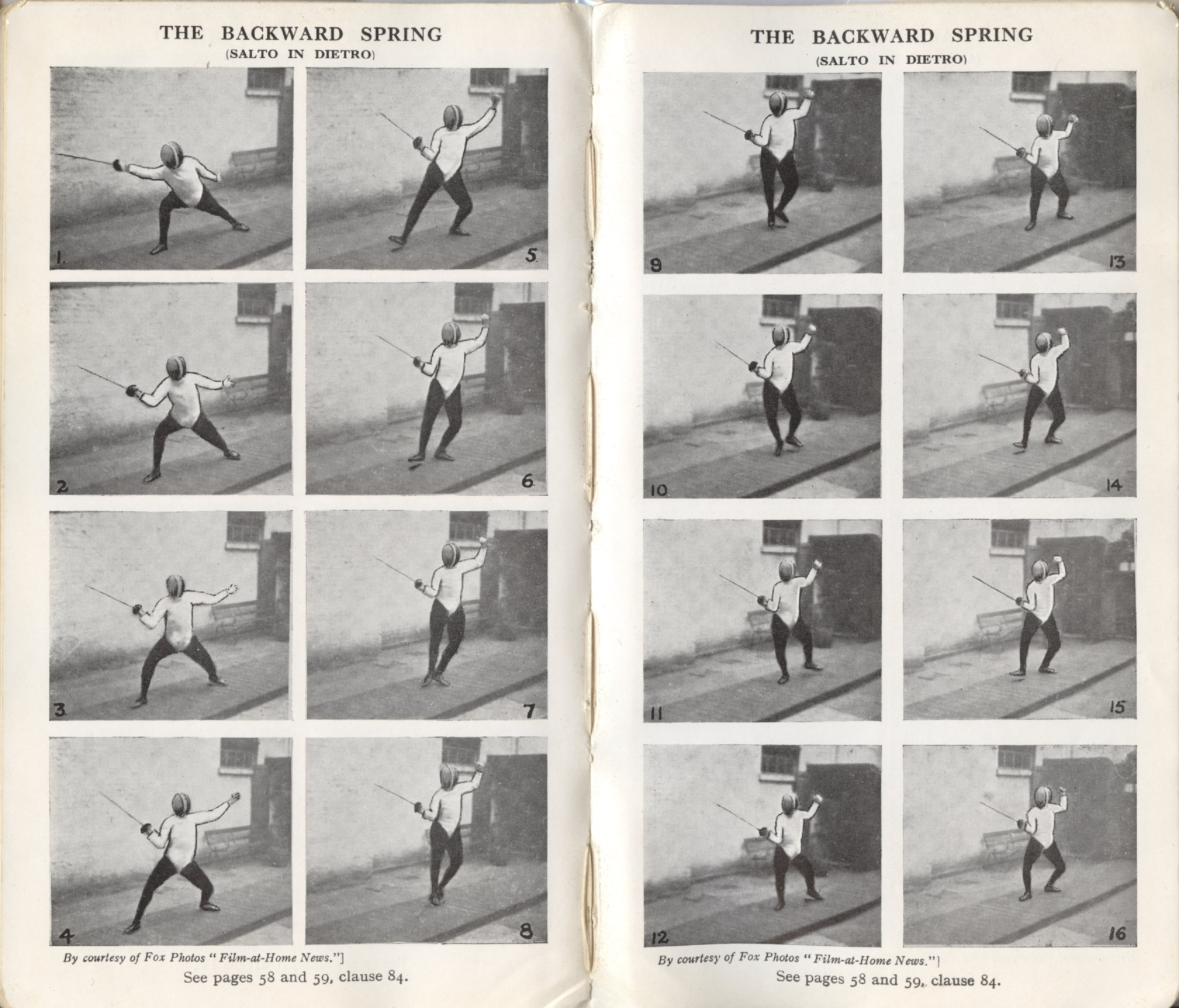
From Bertrand. The backward spring was used to great effect by Edoardo Mangiarotti, although as an epeeist he tended to spring back into a rassemblement with a straight-arm counter-attack, not a parry or en garde.
The Fencer’s Companion by Léon Bertrand, 1934 to 1958 and possibly later. A delightful little book, hardcover but pocket-sized, with enough information on all three weapons to substantially educate fencers from novice to intermediate-advanced, with fundamental lessons required at all levels of fencing. The book also includes useful advice on teaching fencing. Prof. Bertrand, son and grandson of famous British fencing masters of French descent, was one of the most influential masters in the history of modern fencing in the UK.
Among Prof. Bertrand’s useful advice is to learn to fence from the beginning with both hands, starting with the weak hand first for balance. It’s advice unlikely to be followed often but it has excellent virtues, and will likely be the subject of a blog post one of these days. Twenty-five years ago I began learning to fence left-handed in order to give left-handed lessons as well as right. Two years ago I seriously incorporated left-handed footwork, drills, and fencing into my regimen, equal those of my right-handed, with quite useful results. Prof. Bertrand also has advice for fencing against classical Italian fencers, in which the counter-quarte and Italian prime (a high septime) dominate. (Note for readers of Imre Vass: his “destructing parries” in quarte and septime correspond to–are equivalent to–these two classical Italian parries that in combination “cut the line” or “destroy” feint attacks in the high line and will parry high-low and low-high feint attacks in the inside line.)
I’d not be surprised to find that The Fencer’s Companion influenced All About Fencing: An Introduction to the Foil by Bob Anderson, in particular the images of technique in action. Whereas Prof. Bertrand includes a series of photos depicting various actions as shown above, Anderson took this a step further so that by flipping pages the reader can see the technique in action, similar to a primitive film. See also Bob Anderson’s book on this page.
The Book of Fencing by Eleanor Baldwin Cass, 1930. The book is particularly noteworthy as it was, and remains, one of only a handful of fencing texts written by a woman, even including modern texts. Ms. Cass was an American, and the book was, not surprisingly, published in Boston, birthplace both of conservative American Puritanism as well as liberal progressive thought. The epee section is sparse, as is often the case with many three-weapon texts, but the foil section is classically thorough. The book is also a great source on much of the fencing history of the day, and thus quite useful to the fencing historian.
The Art of the Foil by Luigi Barbasetti, 1932. The Italian foil. Includes a succinct but thorough history of fencing, a good section on tactics, and a glossary of fencing terms in English, French, Italian, and German. A useful book for epeeists as well. Barbasetti was one of several Italian fencing masters who carried Italian technique to Hungary and Austria, including to the Austro-Hungarian Normal Military Fencing School of Wiener-Neustadt in 1895 where he re-organized it. (Alfred Tusnady-Tschurl, one of my “fencing grandfathers”—the fencing masters of my own fencing masters—was a graduate and had studied under Barbasetti.) Italo Santelli was the most notable of these Italian immigrant masters. Santelli famously said that fencing is something you do, not something you write about—thus there is no book by Santelli in this list.

Castello, no comment needed other than “Don’t miss with your stop thrust!” This type of angular counter-attack was popular in sport epee but was not recommended in dueling, as it would in all likelihood not arrest the attack. “I hit him in the wrist but he put my eye out,” is not a desired outcome in a duel.
The Theory and Practice of Fencing by Julio Martinez Castelló, 1933, & Theory of Fencing, 1931. One of my favorite dozen or so fencing books. The author was trained in the early 20th century Spanish school, which was based on the best of the French and Italian, including a modified modified French grip that gave it the (theoretical) point control of the French grip with the strength of the Italian grip. (This grip is illegal in modern competition, although a pistol grip variation without an external weighted pommel exists that is legal, if you can find it.) The Neapolitan Italians were the first to formally attempt to combine the French and Italian schools on any scale, followed by the Spanish and, via the Italians, the Hungarians, although fencing “schools” have always adopted technique from each other and adapted it to their own methods. However, in both editions the author notes that the book, which he wrote to help “young men and women in the many schools and colleges” in the US, including those without a teacher, is not based entirely on any particular system, although he says the foil is mostly French, the saber Italian, and the duelling sword (epee) from his own experience.
The author notes that at the time he wrote his book the French school predominated in the US, and this remained largely true at least until the 1970s, in foil and epee especially, in spite of an influx of elite Hungarians in the 50s and 60s. (I was often told in the late 70s and early 80s that I fenced epee like a pentathlete, rather than conventionally, French, that is: in fact, I fenced like a Hungarian, although notably my lessons from two Hungarian masters and one French master–the famous Michel Sebastiani, French-Corsican, and a former pentathlete–were seamless and very similar.) Saber in the US was by the 70s largely Hungarian, at least among the best sabreurs. Castelló also writes that the predominant saber school circa 1930 was Italian, but in fact by then the Hungarian school, based on the Italian but modified to suit Hungarian attributes, was dominant. But this is a quibble, yet I’ll add one more: Castelló repeats the canard about the saber target being limited from the waist up because it was a cavalry weapon, i.e. one didn’t hit the horse. This is arrant nonsense, still repeated today. The target in saber is based on an old Italian rule that limited the target to the area above the waist in order to protect a duelist’s manhood. This is noted in numerous late 19th century Italian texts.
Castelló had also self-published a smaller volume, Theory of Fencing, in 1931. Copies could be ordered from the author himself for $2. The more detailed 1933 version was released by noted publishing house Charles Scribner’s & Sons. Both books–the later book is simply an expansion of the first in both text and illustration–are excellent sources of fundamental fencing theory and technique, knowledge often far too lacking in many fencers today. Castelló included an excellent description of the two most classical epee styles–“straight arm” and “bent arm”–and associated technique and tactics. (See Lidstone’s later edition above for others.)
Among Castelló’s students was Joseph Velarde, the West Point Military Academy fencing master whose stand against racial discrimination opened US collegiate fencing competition to black fencers. By coincidence I once worked with Velarde’s son, a former US Marine Corps officer, many years ago. A decade before that I had fenced with and competed against the founders of the old M.A.R.S. Fencing Club at the Marshall Space Flight Center in Huntsville, Alabama, most of whom were among the Apollo engineers who put humankind on the Moon. (The fourth was and is a brilliant Byzantine iconographer.) One of these veritable musketeers, Joe Dabbs, who has since passed away, had trained for years under Velarde. I have remained friends with all of these old M.A.R.S. fencers for almost forty-five years, and most were active fencers until recently as age and old injuries restrained them, although I still fence with one of them regularly (Elias Katsaros, with French grips and true “hit and not get hit” dueling practice only!). John Jordan and Donny Philips—the other two members of the Four Musketeers—are also still with us.
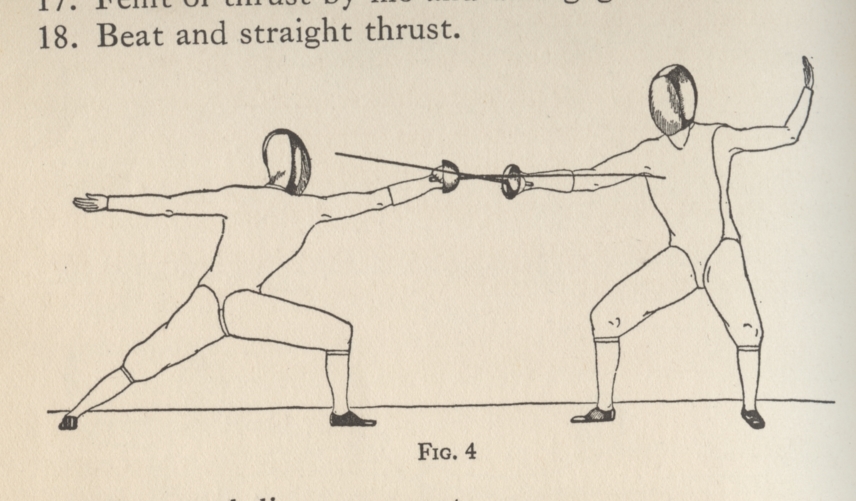
Barbasetti, a filo (bind) thrust in tierce. Note that the Italian bind thrust or filo is a thrust with strong pressure in the same line: it is neither a French liement nor, arguably, quite equivalent to a pression or graze, for it is generally delivered with more strength than the latter. This thrust is commonly made today in sixte. The filo thrust in the high outside line has been a staple of dueling sword technique for centuries, given its relative safety.
The Art of the Sabre and the Epee by Luigi Barbasetti, 1936. By one of the great early twentieth century masters. The epee section is quite sparse, and refers the student to the foil for much technique, a quite common practice in many of the Italian schools, given the similarity in technique and practice between the two weapons. Castello’s book (see above) has a far more thorough epee section.

From Fencing Comprehensive by Félix Gravé, 1934.
Fencing Comprehensive by Félix Gravé, 1934. A delightful and, too my mind, too short fencing treatise covering foil and epee, filled with pithy fencing wisdom that has never been out-of-date. The author’s general observations are also noteworthy. For example, the truly classical fencer in form and technique is born, not made. (Not to worry, those of you in the majority who weren’t born to fit into the classical mold–even in the days of “classical fencing” such fencers were rare, and one need not fit this mold in order to be a great fencer. Anyone who tells you otherwise is ignorant and probably, to quote The Princess Bride, selling something.) Gravé has good advice for teaching, on dealing with some of the more common types of fencer, on tactics in general, and for conducting a duel. For the fencing historian, he has several drawings of period fencing grips, the French interchangeable epee system (l’épée démontable), various guards (coquilles), pommels, points d’arrêts, the development of the fencing mask, &c. Interestingly and happily, he mentions women epeeists, and has an illustration of the clothing they should wear (“men’s,” basically) long before epee was permitted to women in competition, a fact that pleases me immensely.
On Fencing by Aldo Nadi, 1943, reprint 1994. A famous Italian fencer’s thoughts, pompous, patronizing, and otherwise, on technique and competition. For Nadi, there was only one correct way to fence: his. Held up as a god by many modern “classical fencers,” Nadi despised the French grip as much as many of the same “classical fencers” today despise the pistol grip and advocate the Italian and [Nadi-despised] French grips. Let no one claim that blind self-irony and hypocrisy, often humorous, even hilarious, never reigns among pseudo-experts, or for that matter, among quite a few true experts.
The Science of Fencing by William M. Gaugler, 1997. A thorough modern description of purely classical Italian foil, epee, and saber technique. Pedagogical, as one would expect, and almost old school military in its technical presentation. Professor Gaugler, a student of Aldo Nadi and other great classical Italian masters, passed away in 2011.
Fencing Tactics
Many books touch on fencing tactics, but to date I’ve found one devoted exclusively to the subject–and it’s one of the best books on the subject of fencing in general I’ve ever read.
Fencing Tactics by Percy E. Nobbs, 1936. By the 1908 Canadian Olympic Foil Medalist, the book is a delight to read and study, easily one of a handful of the most practical fencing books ever written, certainly one of my handful of favorites even if I don’t agree with everything–and is a book generally unknown to nearly all fencers these days. It is also one of only two books by Canadians on this list (see also Bac H. Tau), and both are outstanding. However, take heed: the book is based on classical notions of tempo and right-of-way, and in some ways is an exposition largely of how the author fenced (similar to the books of Nadi and Harmenberg, for example).
Mr. Nobbs covers tactics in depth, better explains the difference between the classical Italian (and by implication, Italo-Hungarian) school versus the French, discusses opposition thoroughly, points out how important footwork is to tactics, and captures well the spirit and practice of each of the three modern weapons. He also describes the difference between free fencing (loose play), competition fencing, and exhibition fencing–and particularly how one should fence and behave in each form. For example, the superior fencer should trade touches with the weaker in free fencing, rather than simply trying to hit as many times as possible.
Mr. Nobb’s discussion of opposition is quite useful, with educational observations on the role played by the bend in the blade as it hits, something that would not occur with real swords and their very stiff blades. This blade bending is less relevant today with electrical scoring in epee, but is still pertinent in the conventional weapons: for example, a counter-attack without priority but whose blade bends as it hits can help exclude the arriving valid attack. In other words, the valid attack might have arrived were the blade to remain straight. The book also describes useful footwork beyond the conventional advance, retreat, lunge, and recovery, most of which is seen today, but not all. We rarely see, for example, the stolen march (forward crossover, lunge) today, although I was in fact taught it decades ago. Still, some epeeists today occasionally use a crossover followed by a fleche, often as a suprise attack after the command “Fence!” is given. Nor do we see the reverse rassemblement (standing as in a rassemblement but by bringing the rear foot forward) to make a counter-attack, a practice once used in foil.
Amusingly, Nobbs includes an epee counter-attack that concludes with a reverse-crossover-spin-jump-retreat! I’m no fan of turning the back in any martial practice, and the described technique would not only run afoul of the modern rule against doing so, and is clearly also pre-electrical, for the fencer executing the technique would be wound up in the reel cord. Still, it would be a swashbuckling delight if executed without error although to what real purpose I cannot fathom: a half-retreat crossover accelerating into a long jump backward would work as well or better and is far more stable–and you can keep your eyes on your adversary the entire time. It’s a conundrum that such a dubious technique–unless I’m missing something–would be included in an otherwise practical work. An inside joke? Probably. In fact, I don’t even care for exposing my back in the fleche when running past an adversary, and prefer instead to fleche straight at my opponent, a technique centuries old and well-described by Sir Wm. Hope. A quick trivium: until the 1940s, in “dry” (non-electric) epee if one fencer passed another, he or she could turn around and continue fencing facing the other way, provided a halt had not been called. Nobbs also provides the third different definition of copertino I’ve run across: fencing language is both used and abused by fencing masters.
Recalling my first fencing master, Dr. Francis Zold, who told me much the same thing, Nobbs points out that the premise of competitive epee at the time, that a hit arriving at the arm of the attacker first would count while that of the attacker would not because the attacker’s body hit would be stopped or delayed by the defender’s arm hit, is flawed. In fact, the majority of counter-attacks to the arm or the body would not halt a fully developed attack. It’s a purely sport technique when done deliberately. The book is one of those I delight in discovering. And it’s printed on high quality laid paper too! Highly recommended–but have a thorough working knowledge of at least intermediate fencing technique first.
Historical Fencing
That Is, To Hit and Not Get Hit–At Least in Theory
Rapier & “Transitional” Rapier

Dutch illustration by Caspar Luyken, 1699, for El Buscon by Quevedo of the scene lampooning la verdadera destreza.
Libro de Jeronimo de Carranza, que trata de la filosfia de las armas y de su destreza, y de la aggression y defension Christiana by Jeronimo de Carranza, 1582. Add to this the works of his student, don Luis Pacheco y Narvaez. The book is the exposition of la verdadera destreza, or true art, and as such is necessary for understanding one of the major schools of Spanish rapier. The style is based much on complex geometric forms derived from the simple theory that discovering the shortest safest path in attack or defense is the basis of speed (in fact, it is but one component). From this proposition the school became wrapped in unnecessary esoterica including elements of mathematics and philosophy that have little if any practical bearing on practical swordplay. Yet it was this esoterica that made it surely lucrative for fencing masters whose students were, as many are today, eager for “secret knowledge.” The system was scathingly and brilliantly lampooned by famous poet, swordsman, and Spanish national treasure Francisco de Quevedo in El Buscón. Quevedo once humiliated Narvaez in a duel: with his rapier he removed Narvaez’s hat. In fairness, it can be argued that the verdadera destreza was an early effort at scientific or rational fencing theory that, albeit with different emphasis, would come to dominate the smallsword in the late 18th and early 19th centuries.
Part of my bias against attaching philosophy, metaphysics, “secret knowledge,” and other such “floral appendages” to fencing is that the allure is primarily to make fencing lucrative to some fencing teachers’ bank accounts and all too often to enrich the teachers’ egos as well as their wallets. I’ve seen a number of modern teachers practice this in Olympic, classical, and historical fencing. It is a pompous, pretentious, and, often to many students, ultimately disappointing practice. Fencing has more than enough fascinating allure, and its lessons are easily applied to life: it need not be wrapped up mysteriously and excessively in mathematics, philosophy, and, to be plain, alchemy. Or, more generally, in esoteric bullsh*t.
That said, one of the best ways to look at the destreza verdadera form may be to consider it as the truly Spanish Baroque style of swordplay, caught up in all that was good and bad in the excesses of the Spanish Baroque period. And if nothing else, at least it suggests you consider that all the arts and sciences are connected.

Don Pedro de Texedo.
Escuela de Principiantes y Promptuario de Questiones en la Philosophia de la Berdadera Destreça de las Armas by Don Pedro Texedo Sicilia de Tervel, 1678. As with the Destreza Indiana below, the author’s name alone is quite evocative. Add to this the author’s image in the front papers, evoking the aloof, Roman-nosed Spanish don (not quite a myth by any means), and we have a book right out of a Hollywood swashbuckler. It has everything for the fencer enraptured by the destreza verdadera, including excellent illustrations of swashbuckling swordsmen—Spaniards, we assume, although their Spanish dress includes baldrics rather than the narrow sword-belts worn by Spaniards at the time except when in military dress, which was basically French—holding classic cup-hilt rapiers and standing on “magic” geometric circles. Discusses rapier and dagger, single rapier, and rapier and target.
The author’s image page includes references to theologia, obtica, practica, astrologia, speculativa, arismetica, matematica, musica, and philosophia, which is quite an education: only by reading the book is the question answered as to whether some or all apply to the destreza verdadera. “All,” I imagine Texedo would say. Further, I am unsure who the audience was: the book was published in Naples, under Spanish rule at the time; the clothing and baldric are a bit curious (perhaps of Spaniards in Naples? Or in Sicily? Or of Italians in Spanish dress?); and the dedication is to His Majesty the King of Spain, of course.
The book’s purpose is clear, though, according to Texedo’s motto: Omnia Contra Tela is shorthand for “unum omnia contra tela Latinorum” from Virgil’s Aeneid, book VIII. The complete phrase translates as “alone sufficient against all the weapons of the Latins” (Benjamin Apthorp Gould, 1826; Latin translation should always be left to serious scholars). Given that destreza is written beneath the motto, it’s pretty certain that Texedo held his practice of philosophical swordplay in high regard.
I imagine Don Pedro Texedo, whom I rank among my favorite Spanish swordsmen, as equal to “John de Nardes of Seville in Spain, who with the dagger alone, would encounter the single rapier and worst him.” (William Higford, 1658. “Juan de Nardes” of Seville is probably Juan Domínguez, noted by F. Moreno in Esgrima Española, 1904.)
Las Tretas de la Vulgar y Comun Esgrima, de Espadas Sola, y Con Armas Dobles by Manuel Cruzado y Peralta, 1702. My many thanks to Pradana who corrected my description of this book. When I reviewed it ten to fifteen years ago, I simply read the title and scanned the text for examples of “common” Spanish rapier, and so I assumed it was a book overall on the comun technique. Pradana pointed out that the text is in fact a criticism of the common method. Mea culpa! He later emailed me to point out that I was partly correct: the text does include descriptions of the common method, as I was certain I had read (in spite of my mediocre Spanish). Thankfully I now do a more detailed review and re-review of sources prior to formal publication. In regard to “comun” texts, Pradana recommends Domingo Luis Godinho. Although I’m aware of this author I haven’t yet reviewed the book, but will post a summary when I do.
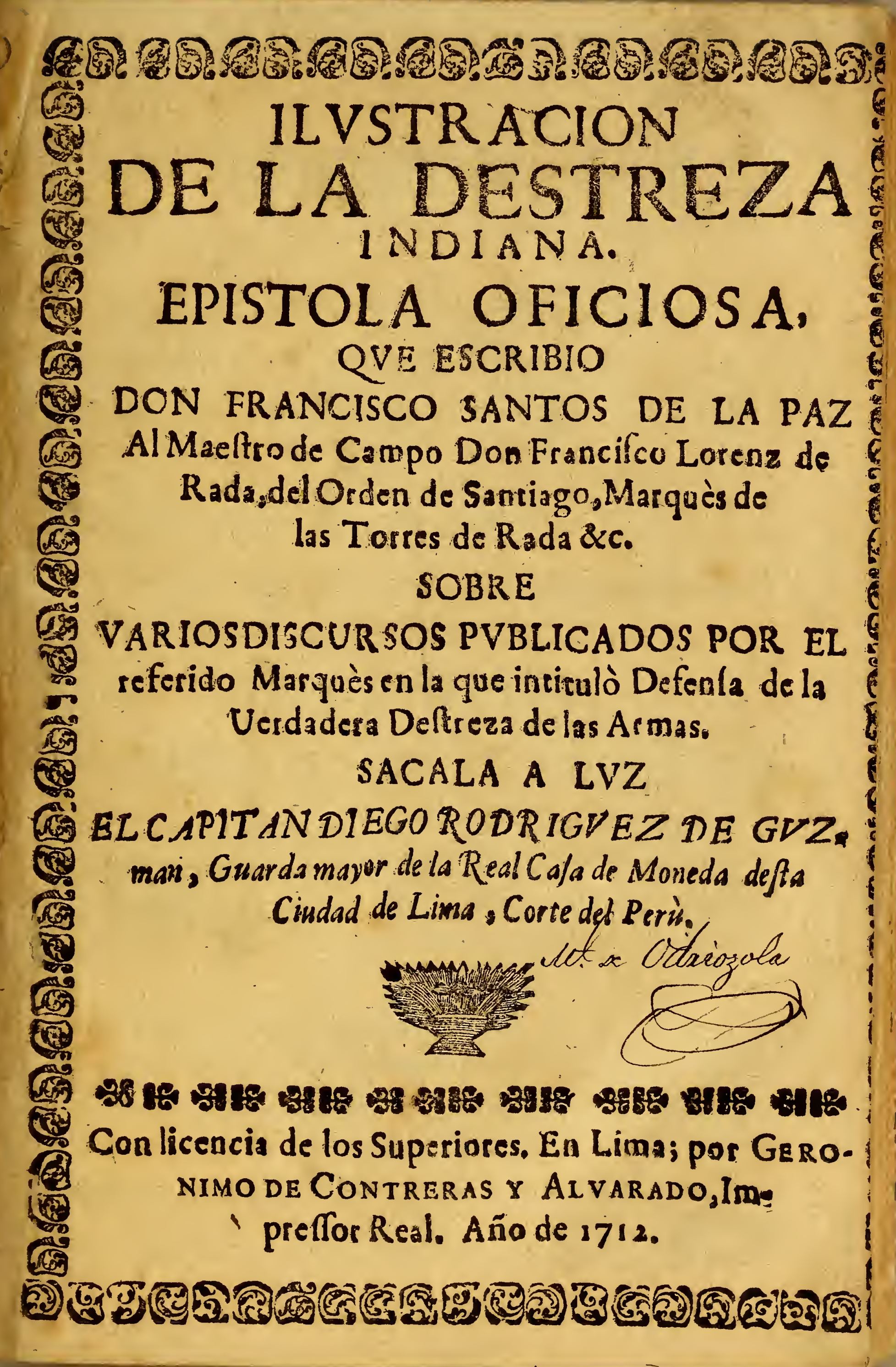
Illustracion de la Destreza Indiana by Don Francisco Santos de la Paz and Capitan Deigo Rodriguez de Guzman: Lima, 1712. Noteworthy primarily because it was the first fencing book, to my knowledge, published in the Americas. The authors’ names alone conjure assignations and affrays fought with rapier and poniard, or capa y espada, at night, not to mention the myth of duels on deck between noble pirate captains and treacherous Spaniards, although to be accurate we should drop the “noble” from pirate captains all of the time unless fictional (for example, Captains Peter Blood and Charles de Bernis), and “treacherous” from Spaniards most of the time. Trust me on this, I write books on the subject. See also Edward Blackwell in the “Smallsword” section below.
Gran Simulacro by Ridolfo Capo Ferro, 1610, 1629. A beautiful 2004 hardcover edition, Italian Rapier Combat: Capo Ferro’s ‘Gran Simulacro,’ edited by Jared Kirby, is available, as is a 2012 softcover reprint.
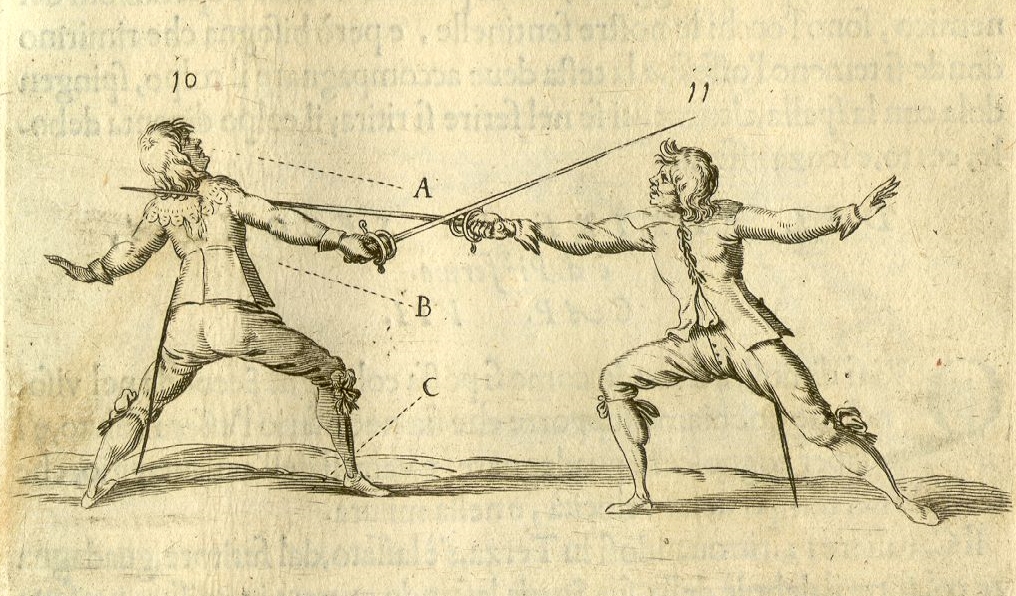
In modern terms, an opposition thrust in quarte. From Alfieri.
L’Arte di Ben Maneggiare la Spada by Francesco Ferdinando Alfieri, 1653. Beautifully and graphically illustrated treatise of the Italian spada, both of single sword and sword and dagger. Highly recommended.
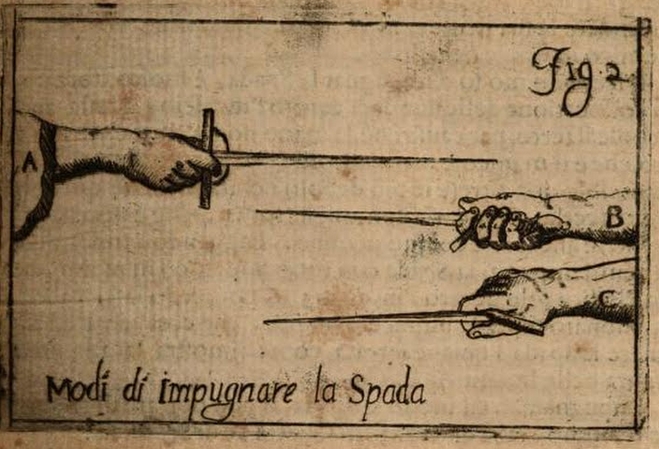
How to hold a rapier according to Marcelli. Compare with Rossi above. In fact, either one or two fingers can be placed within the arm of the hilt. In general, I’ve found that a single finger works best for me with a rapier, and two with the much lighter 19th-20th century Italian foil.
Regole Della Scherma by Francesco Antonio Marcelli, 1686. Detailed, practical study of the Italian spada, including single sword, sword and dagger, and sword versus other arms and vice versa, for example the saber or scimitar versus rapier. A very practical book with sound, practical advice useful in rapier, smallsword, and epee. Dedicated to Queen Christina of Sweden, who had abdicated her throne and now resided in Rome. Greta Garbo starred as Queen Christina in an excellent film of the same name.
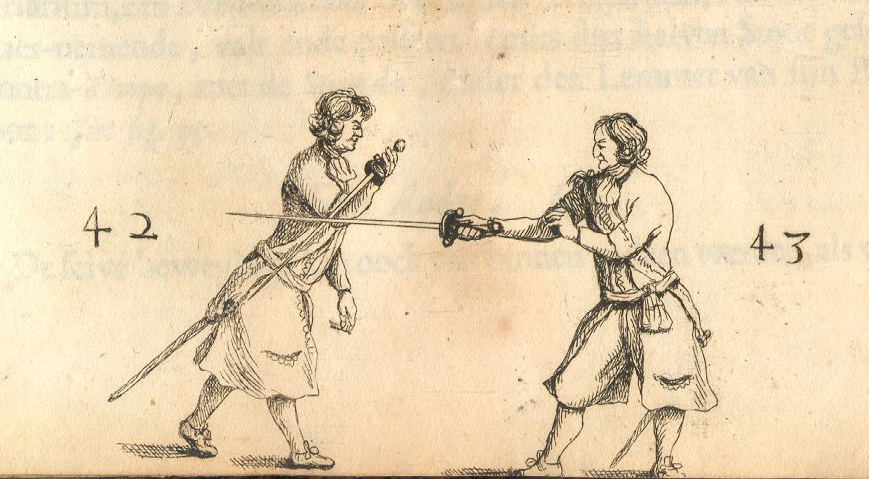
The “high octave” (a nineteenth century term) as illustrated in Bruchius.
Grondige Beschryvinge Van de Edele ende Ridderlijcke Scherm-ofte Wapen-konste by Joannes Georgius Bruchius, 1671. A Dutch text presaging the persistent influence of the rapier into the age of the smallsword in Northern European schools—the Dutch, the various German, and others. Notably, in spite of the date and obvious transitioning to a lighter weapon, the book still uses much Italian rapier terminology. Solid technique for the duelist, soldier, and brawler, much of it looking remarkably similar to modern epee. The author references various illustrations throughout the book, in order that the reader may put them together in different described sequences. Clever, but unfortunately cumbersome too, as one might expect.
The book illustrates one of the most practical uses of what Alfred Hutton, in saber, refers to as “high octave”—used, that is, here as a yielding parry from quarte to exclude the adversary’s blade after running him through. Immediately closing the distance and commanding the adversary’s blade was vital. An adversary is seldom dead or disabled immediately, after all, and this technique would prevent him (or, rarely, her) from making a killing thrust in revenge, assuming a perfect world of course. Not everything goes according to plan, or so Fortune is said to say and without doubt often proves. Some nineteenth century saber masters recommended its use to counter-parry a quarte riposte made in opposition, suggesting that it was the only parry that could be made quick enough, which at the distance of direct riposte may be true. Hollywood is occasionally enamored of the technique, but it’s usually cringeworthy to watch the lovefest, so stilted, weak, and inappropriate in execution—unbelievable, in other words—it usually is.
See George Silver in the “Broadswords…” section below for a passionate argument against the rapier.
Smallsword (Epee de Rencontre, Espadin)

Seconde parry against a thrust in seconde from de la Touche. The lunge is over long and the rear foot has been rolled onto its inner edge probably for extra reach, not security. Note the typical crowned guard of the French foil and the fencing shoes worn over a thick pair of extra socks.
Les Vrays Principes de l’Espée Seule by the sieur de la Touche, 1670. The establishment of the modern French school of the smallsword, whose principals went largely unchanged for more than three centuries, and remain much in place today. Fencing for the French court. Although the technique is practical as described, or at least what would soon be considered conventional, and later classical, the illustrations show a lunge absurdly long, one that could hardly be recovered from in good time or in good defense. Perhaps it was to please Louis XIV and his tastes in elegance and dance.

Plate from de Liancour illustrating on the left the discovery that the adversary elevates the hand when parrying with the forte, and on the right the method of opposing this with a feint to the head and a disengage in seconde. Elevating the hand when parrying sixte to cover the outside line is common in epee, and is vulnerable exactly as illustrated above.
Le Maître d’Armes ou L’Exercice de l’Epée Seule dans sa Perfection by Andre Wernesson, Sieur de Liancour, 1692. An excellent study of the smallsword, albeit in some ways more suited to gentilshommes of the French court than to adventurers in the field, although the author does cover commanding and other disarms. Julie d’Aubigny, aka Mademoiselle la Maupin, the opera singer and duelist, among other occupations and pastimes, may well have studied under Wernesson, maître en fait d’armes to the Petit Ecurie, given her swashbuckling father’s position at court as the secretary to the comte d’Armagnac. (She might also have studied under Jean or François Rousseau, maîtres en fait d’armes to the Grande Ecurie.)
La Maupin, among her many adventures, was convicted and subsequently sentenced in absentia to be burned to death by the Parlement d’Aix for seducing a novice and burning a corpse in the associated convent. The verdict, however, was delivered against the sieur d’Aubigny; La Maupin’s masculine disguise apparently fooling, or perhaps pretending to fool, the right people. The criminal seductress’s former protector, the comte d’Armagnac, petitioned Louis XIV to overturn the decision, which he did, doubtless given his strong inclination toward attractive talented women. Clearly, independent women were hard to come by—and apparently hard to spot when dressed as a man fleeing a convent and prosecution.
L’art des armes by le sieur Labat, 1696. English translation, The Art of Fencing by Andrew Mahon, 1734. Another excellent study of the smallsword, although Labat, like de Liancour, was not quite as practical-minded regarding the smallsword in sudden rencontres, street fights, and the battlefield as some authors, McBane for example, were. From his work, as well as Hope’s below, it is easy to see the origins of sport fencing, aka foil fencing. In fact, I suspect that most fencers of this era far preferred “school play” to the possibility of injury or death in a real rencontre.

From Sir Wm. Hope, a French en garde on the left, and his early-recommended guard, although he would change his recommendation twice, once to a more conventional guard, then last to the “Falloon” or hanging guard common the Walloons, Dutch, and Germans.
The Compleat Fencing-Master by Sir William Hope, 1692, 1710. Largely a reprint of Hope’s earlier work, the Scots Fencing Master, or Compleat Small-Swordman, 1687. An excellent work, highly recommended. Hope was an astute amateur, and his observations on fencing concepts are valuable to both the historical and modern fencer. Additionally, he has much practical advice for fighting with “sharps.”
The Sword-Man’s Vade-Mecum by Sir William Hope, 1691, 1694, 1705. Excellent advice for surviving a fight with “sharps.” That is, practical considerations for dueling and “rancounters” (rencontres) or street fights.
The Fencing-Master’s Advice to His Scholar by Sir William Hope, 1692. Rules and advice, including technique, for “school play”—that is, for sport fencing. Ever wonder where foil conventions and rules come from? In spite of most historical texts noting that conventions originally derived for reasons of safety, it is clear that sport, convenience, and appearance also played a major role, perhaps even the greater one, starting in the late 17th century, if not much earlier.
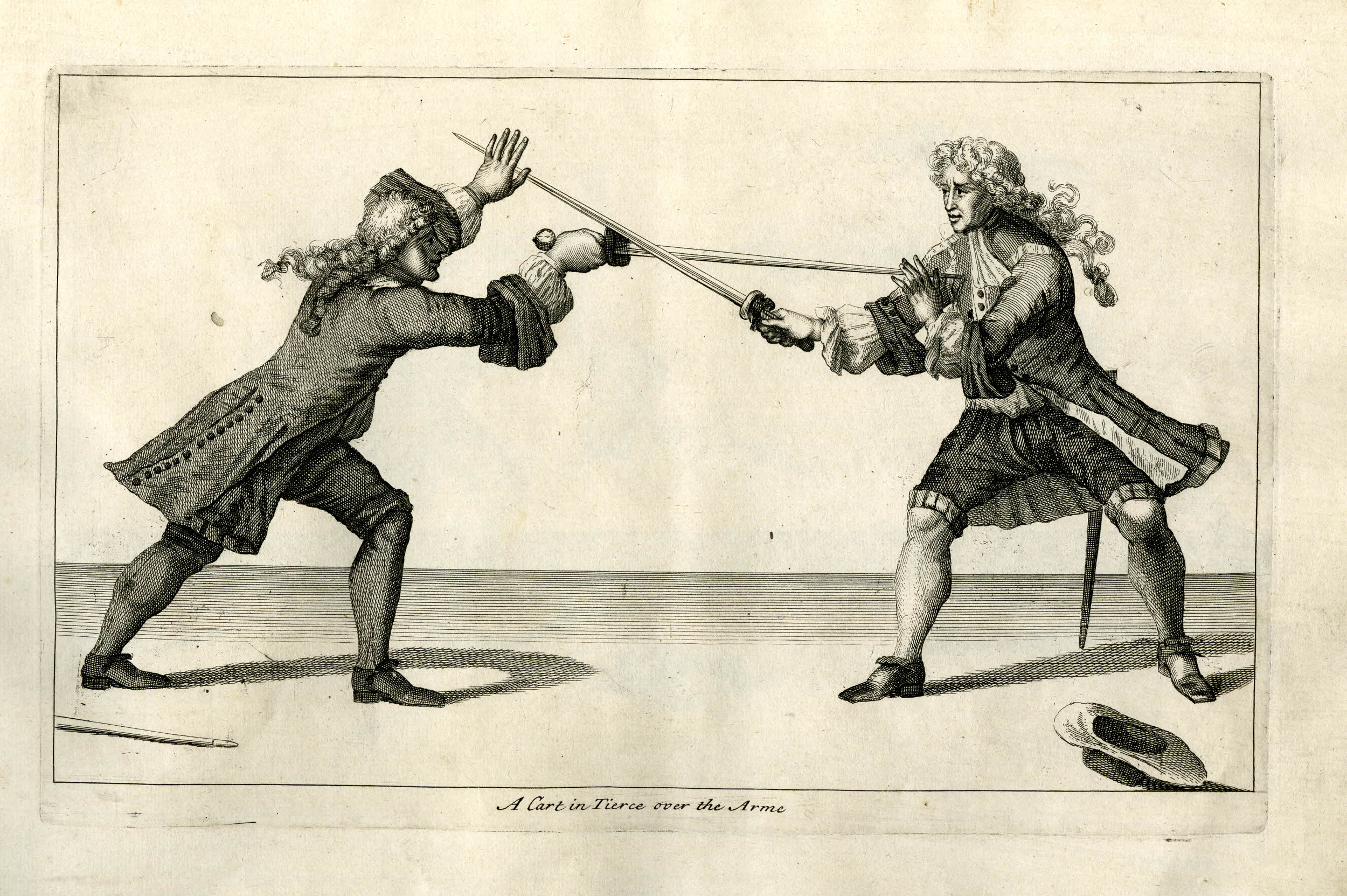
Laroon’s “A Cart in Tierce over the Arme”–the hand turned in quarte in the tierce position. Here, in the form of an angulation in sixte with the unarmed hand opposing, against a tierce.
The Art of Fencing Represented in Proper Figures Exhibiting the Several Passes, Encloses, Disarms, &c. by Marcellus Laroon, various editions suggested to date from the 1680s to circa 1700. Illustrations and single line descriptions only, very useful to the historian not only of fencing but of period dress. (I’ve relied heavily on these images for Fortune’s Whelp, for example.) Figures are in a variety of fencing positions, most with smallswords, some with buttoned foils. Worthy of much study. A number of images are suggestive of, or even imitated from, 17th century rapier and “transitional rapier” illustrations, making it at quite possible, or even probable, that the French school was not yet entirely in full force even in the English smallsword, or that the Dutch immigrant illustrator Laroon, who bore a facial scar from an affray with swords, was showing his Dutch influence. (See Bruchius in the “Rapier & Transitional” Rapier section, for example.)
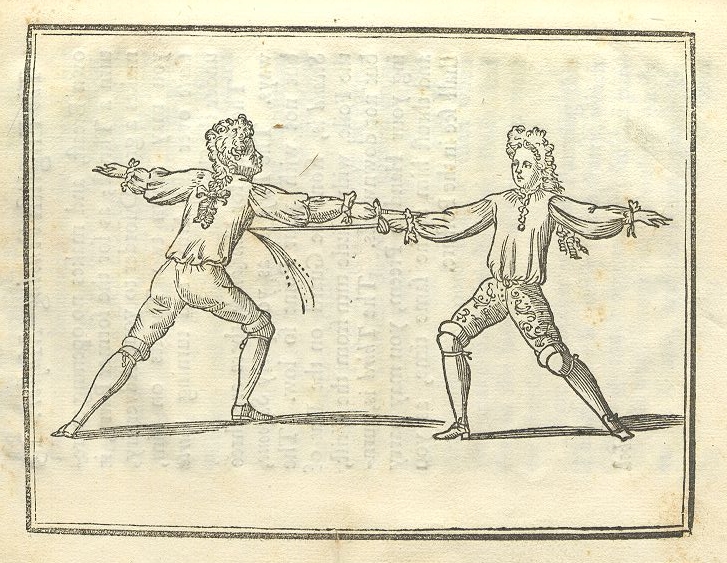
Illustration from Henry Blackwell of a parry-riposte made in a single tempo against a flanconade–an imbrocatta, in other words.
The English Fencing-Master: or, the Compleat Tuterour of the Small Sword by Henry Blackwell, 1702. A short text thereby suggesting that “Compleat Tuterour” is hyperbole, with decent illustrations showing wounds with spurting blood for emphasis. Includes more proof that the modern sixte thrust aka “carte over the arm” was well in use much earlier than some fencing historians suggest. Charming spelling of seconde: “Sagoone.” But the spelling of carte, tierce, and prime are conventional. Blackwell includes a good but brief discussion of flanconnade, one of my favorite thrusts in its several varieties: it secures the adversary’s blade, is perfectly placed for additional opposition with the unarmed hand (were this still legal), and, thrust low, avoids the ribs and their cartilage which might impede the thrust (assuming the adversaries are fencing with “sharps” of course). Blackwell’s recommended en garde is with the arm mostly extended, as is the case with many smallsword texts—it’s simply a safer guard with a real thrusting sword than the common foil guard of the past two centuries. See also Edward Blackwell below!

Opposition with the unarmed hand while thrusting. Note the buttoned German foils with shallow round shells and crossbars. The en gardes are derived from rapier-play. From Schillern.
Der Geöffnete Fecht-Boden by B. Schillern, 1706. German text showing the influence of the rapier even with the smallsword into the 18th century. Compare with Doyle’s French-influenced German text below and with Bruchius’s Dutch text in the “Rapier” section above.
Advertisement, Especially to Fencing Masters by Sir William Hope, probably 1707. An advertisement with argument for Hope’s new book detailing his new method of fencing using the hanging guard. Excellent, if brief and not entirely complete, discussion as to why swordplay on the battlefield is different from that of the duel. (He doesn’t provide reasons why cutting weapons, or cut and thrust, are preferred: cuts may not kill but often disable more quickly that thrusts, it is easier to change direction and defend while doing so with a cutting weapon, thrusts may stick in the adversary and thereby be problematic for mounted troops–many have been dismounted by a thrust stuck in an enemy.) Hope is less convincing when it comes to his argument that his method is new, and not merely a restatement of one of the Walloon or German styles.
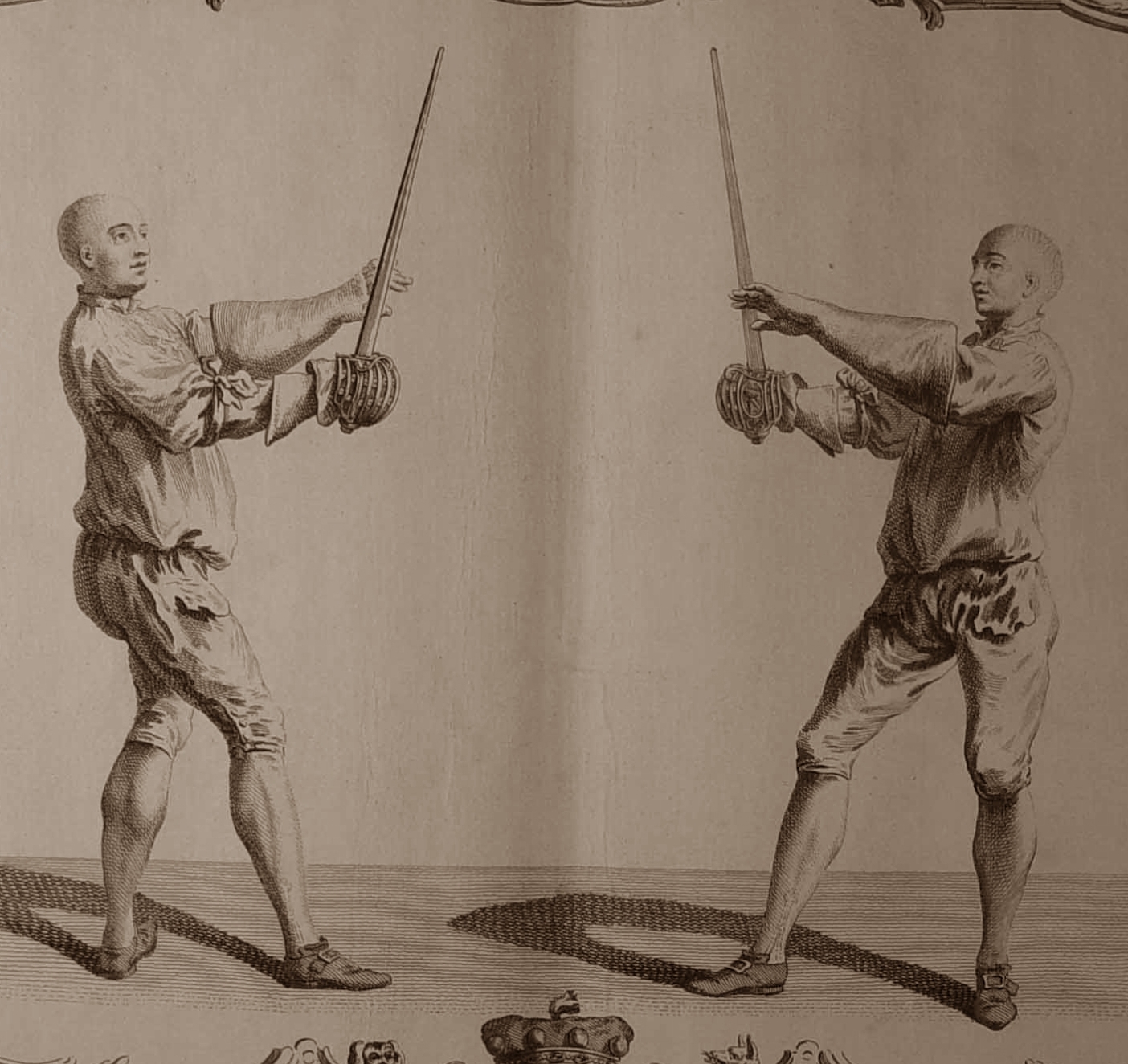
Illustration of backsword and great gauntlet from Miller (see “Broadswords” below). Hope recommended the use of the great gauntlet on the battlefield.
New Method of Fencing by Sir William Hope, 1707, 1714, et al. Hope’s exposition of his conversion to the hanging guard, known by many as the “falloon” (from Walloon) guard, as opposed to the more common guards in quarte and tierce, for the smallsword, sheering sword, and backsword. The book has been reprinted in Highland Swordsmanship, edited by Mark Rector, 2001. Among his excellent advice for swordplay on the battlefield, Hope recommends a stout gauntlet on the unarmed hand for parrying.
The English Master of Defence: or, the Gentleman’s Al-a-Mode Accomplishment by Zackary Wylde, 1711. A difficult read at times, especially for those without a strong base in classical fencing, smallsword, and backsword/broadsword technique, not to mention in English syntax and phrases circa 1700, but the language is colorful, the writer charmingly self-confident, and his descriptions—once deciphered—proof that there is little new in “modern” fencing. Covers smallsword, broadsword, quarterstaff, and wrestling.

Quarte parry with opposition of the hand, with riposte in tierce cavé (angulation), from Doyle.
Neu Alamodische Ritterliche Fecht- und Schirm-Kunst by Alexander Doyle, 1715. An Irishman introduces Germans to the French school, with plenty of parries and oppositions with the unarmed hand, plus disarmings, grapplings, and trips/throws to satisfy advocates of the native German schools. Almost as well-illustrated as Girard below, and in some ways I almost prefer Doyle’s illustrations. An excellent reference for the practical-minded swordsman.
Expert Sword-Man’s Companion by Donald McBane, 1728. McBane was a Scottish soldier, swordsman, fencing master, duelist, prize fighter, and collateral pimp whose deeds and escapades began in the late 17th century and continued into the 18th. Highly recommended, almost certainly the best text on practical swordplay for the duel, affray, rencontre, street fight, &c, based as it is on his own extensive experience wetting his blade with the blood of adversaries, and occasionally wetting theirs with his own. Literary connection: in The Princess Bride the author refers to McBane as “McBone.” The book has been reprinted at least three times in recent years: a 2015 edition edited by Keith Farrell in Scotland, a 2017 edition edited by Jared Kirby, and a 2001 edition edited by Mark Rector in Highland Swordsmanship (readers of this last edition may choose to disregard the photographs of McBane’s technique and refer instead to McBane’s descriptions and original illustrations which are unfortunately not reproduced in this edition).
A Compleat System of Fencing: or, the Art of Defence, In the Use of the Small-Sword by Edward Blackwell, 1734, in Williamsburg, Virginia. The first fencing text published in North America and the first in English in the Americas as well, sub-titled Wherein The most necessary Parts thereof are plainly laid down; chiefly for Gentlemen, Promoters and Lovers of that SCIENCE in North America. Given the last names plus the similarity of titles and technique, Edward Blackwell is surely related to Henry Blackwell, most likely as father and son. The book includes a good introduction as to why one should fence—Americans, take note! It’s apparently long been a problem promoting swordplay in British-derived North America!—as well as solid descriptions of swordplay, including how to deal with a low guard, in “Master and Scholar” format (Sir Wm. Hope has used this format too).
As with Henry, the book has a good description of the flanconnade, and the likely son has corrected the likely father’s spelling of “Seconde.” Good discussion of time and counter-time, along with a reminder that foilists have long been inclined to impale themselves by attacking into an attack (so have many epeeists, too, but foilists tend to regard double hits as imaginary). Like his likely father, the son prefers a more extended guard, and not the scandalously “crooked Arm” so popular with foilists since the 19th century—but at least most of them extended from beginning to end during their attacks until recently—and also with aggressive “ignorants” of the smallsword era who did not extend during their attacks. Yes, attacks with a bent arm are those of the fencing illiterate, thus one might argue that both modern foil and saber fencers are quite unlettered (and some epeeists are too). See also Henry Blackwell above.

Riposte in prime with opposition of the hand in Girard. The thrust is referred to as tierce in cart by some authors. Girard’s book is the best illustrated of all smallsword texts.
Traité des Armes by P. J. F. Girard, 1737, 1740, et al. Possibly the best book on the smallsword ever written. Not only beautifully illustrated, the book describes smallsword technique in detail, including its use on the battlefield against other weapons. It emphasizes practical swordplay for the duel as well as for the affray or rencontre, even against foreign fencing styles, and for battle. Girard was a naval officer. Highly recommended.
A Treatise Upon the Useful Science of Defence, Connecting the Small and Back-Sword, and Shewing the Affinity Between Them by Capt. John Godfrey, 1747. Practical book on smallsword and backsword, including a very useful analysis of backsword prizefighters, and some notes on boxing as well.

Illustration to accompany Danet’s advice on how to separate two dueling combatants. Unfortunately, the image is sometimes incorrectly captioned as illustrating how to fight two adversaries at the same time.
L’Art des Armes by Guillaume Danet, 1766. Excellent work on the smallsword, with practical exposition of the theory and practice, along with useful associated exotica, including how to break up a duel (grasp the shell of one adversary’s sword and direct your point at the other). However, the Internet being what it is—as useful to the lazy in their laziness, fools in their folly, and idiots in their idiocy, as it is to those largely unafflicted with these defects of behavior and intellect—the illustration is unfortunately reproduced on occasion to demonstrate, quite incorrectly, how to fight two adversaries simultaneously.
Among much useful commentary, Danet demonstrates his functional knowledge of fencing history and texts; decries commanding the blade (seizing the adversary’s sword) and disarmaments, but discusses them anyway because the fencer should know how to defend against them; discusses and decries volts and the passata soto (under another name); and wishes that parries with the unarmed hand had never been invented, although he distinguishes between parries with the hand and opposition of the hand, the latter of which he approves.
Danet provides the modern definition of fencing time: the time it takes to perform any single action of hand or foot. On the other hand, his renaming of parries is confusing to modern fencers, and was to his contemporaries as well. La Boëssière père, via his son (see below) was highly critical of Danet in general (not unusual in itself for fencing masters to criticize each other, often pompously), although it is easy to see from both that the “practical” swordplay of the smallsword was in danger of descending into near-complete artificiality, which in the next century it did.
In spite of its many virtues, my fondness for the book is actually based much on Rafael Sabatini’s affection for it, on which he founded much of his description of French swordplay, particularly in Scaramouche. Danet’s style of fencing is very much in keeping with the style of Sabatini’s logical intellect, and therefore of Sabatini’s swashbuckling heroes, although Sabatini, being half Italian, did not shrink from occasional cunning, nor did he object to his swordsmen partaking occasionally from the Italian school. From Danet is the inspiration for Andre-Louis Moreau’s new theory of swordplay, although in reality it would be nullified by an arrest, not to mention difficult to execute even with a cooperative adversary. But don’t let this spoil the excellent novel, which among its many virtues great and small is an evocative description of a fencing lesson that stirs me to this day. And in many ways Sabatini’s theory was correct at its core: the fencer should force his or her adversary into a pre-selected avenue of no escape.
Sabatini also used the historical person of Danet in the short story, “The Open Door” in Turbulent Tales (1946). For more details on Sabatini and Danet, not to mention, and far more importantly, on Sabatini’s works in general, I highly recommend Romantic Prince: Reading Rafael by Ruth Heredia, 2015. I am honored to have assisted Ruth on the subject of swordplay in Sabatini’s works.
The Fencer’s Guide by Andrew Lonnergan, 1771. Practical smallsword-play described with some occasionally uncommon fencing language: the practices of whirling, wrenching, and lurching, for example, which are synonyms for three conventional techniques. A more scholarly and readable update on Wylde is one way of looking at the book. Lonnergan also includes a very useful discussion of the backsword and spadroon, as well as some very practical advice for and against the cavalry, dragoons, and Hussars or light horse—whether the adversary wears breastplate and helmet determines to a great degree the swordplay used. He has brief useful advice for the fencer armed with a walking stick (it must be wielded a bit differently, having no edge or point), and sees no reason that an athletic fencer cannot use the various volts, night thrust (passata soto), grapplings, &c, which by now many masters had lost favor with. However, see Danet above.

Direct riposte from octave parry in McArthur. As with Angelo’s illustrations, the figures are much too posed, in postures not likely to be seen in reality except at relatively slow speed with a conforming partner. The figures do reflect the purported “scientific elegance” of the era.
The Army and Navy Gentleman’s Companion; or a New and Complete Treatise on the Theory and Practice of Fencing by John McArthur, 1784. Solid exposition of the smallsword, with conventional language—McArthur doesn’t use Lonnergan’s romantically descriptive flourishes when naming some techniques. Again, here is yet another book proving that there is really nothing new in modern fencing. As with many fencing books, it includes some useful and some not so useful tidbits, for example, the deflecting of a pistol with a smallsword, something I suggest should not have been tried except in extremis and was probably most successful when used with a strong cutting sword—a broadsword, backsword, saber, or cutlass—that, rather than deflect the pistol, severed some of the fingers or the hand holding it instead. Very much worth reading, as for that matter are all the smallsword texts listed here, in order to expand one’s perspective on the theory and practice of Western thrusting swords.
The School of Fencing by Domenico Angelo, 1787. Several modern reprints available. The height of the 18th century French school, though by now the smallsword was mostly an accoutrement of dress, occasional dueling arm, and for some military officers, a badge of office. Fencing for the gentleman. The book is not my favorite, even though it was also published under “Escrime” in Diderot’s famous encyclopedia. Perhaps it’s the illustrations: I cannot image any serious swordsman or swordswoman posing so delicately. For the latter part of the 18th century I much prefer Danet, Lonnergan especially, and even McArthur (whose illustrations are likewise a bit too delicate to represent the soldier and fighting seaman in my opinion).
The Amateur of Fencing by Joseph Roland, 1809. Highly recommended for all fencers. Although the technical material is quite useful to the smallsword fencer and worth reading by the modern fencer. In particular, Roland, first quoting McArthur above, recommended the study of fencing to navy men, for “they are more frequently at close quarters with the enemy than the military are.” But the book’s real value lies in his philosophy of teaching fencing and learning to fence. Specifically, he attempts to go beyond the mere mechanical practices of teaching fencing and of fencing itself, practices still far too common even today. In fact, such mechanical description is the entire content, or nearly so, of most books on fencing, then and now. Roland wished to go beyond this and develop a sense of tempo, tactics, awareness, and independence in the student.
Most valuable are several of his admonitions, for example, “[T]he pupil, who I wish at all times to make use, but not too hastily, and without partiality, of his own judgement, and not upon every occasion to take for certain evidence any proposition upon the authority alone of a master, merely because he is a master, or that the same may be found in print.” Although there are masters who have embraced this philosophy today (including mine), the majority do not appear to have done so and remain instead “mechanical.” Of these, too many reign at the center of a cult of personality, with the result that their students are anything but independent on the piste or, unfortunately, in life.
Traité de l’Art des Armes by La Boëssière fils, 1818. An explication by the son of the school of the father (a contemporary of Angelo and Danet, among others). Highly recommended, especially for the student of the smallsword or of fencing history and theory in general. A superb text, with useful observations (practiced too little today, both in the making and the study of) for teaching students, including the young, the old, and women too, along with practical tidbits, for example an early discussion of the use of the fencing mask (masque de fil-fer, that is, iron wire), instructions on how to mount and button a fleuret d’assaut, and a criticism of the quality of the “new” foil blades, something common throughout the history of fencing it seems: I’m old enough, for example, to have used the superbly-balanced, light, long-lasting non-maraging Prieur foil and epee blades forged in the 1970s (there were no maraging blades back then).
Traité de l’ Art de faire des Armes by Louis-Justin Lafaugère, 1820. Perhaps, along with the only secondarily-described method of Jean-Louis (see below), the last of the great treatises of the smallsword. After this date, and until the development of the épée de combat, we find mostly foil fencing in the form of what was once known as “school play”—sport fencing, or worse, le jeu de salon, in a form unsuitable for combat with sharps. Lafaugère, a redoubtable fencer and swordsman (there is a difference), wrote in detail of the many variations of feints and their many combinations, making the book, to some, overly complex. The only modern text comparable in similar complexity is Imre Vass’s grand epee book (see the “Modern Epee” section above) in which he details feint attacks in similar fashion.

Jean-Louis.
Un Maître d’armes Sous la Restauration : Petit Essai Historique by Arsène Vigeant, 1883. Strictly speaking, a biography of one history’s most swashbuckling and talented swordsmen and fencing masters, Jean-Louis. Like Alexandre Dumas who gave us some of the greatest swashbuckling and historical novels ever written, Jean-Louis was of mixed black and white French Caribbean descent. The book is listed here because Vigeant includes a detailed description of Jean-Louis’s teaching method, along with many of his drills, quite modern and still useful today. In any case, Jean-Louis’s story alone is a magnificent read. His daughter, if I recall correctly, was a quite talented fencer, too. For those of you who don’t read French, Michel Alaux includes a detailed biography of Jean-Louis (see the “Combined Modern” section above). Jean-Louis’s salle survived into the 20th century, and Alaux was its master for some years.
Backsword, Broadsword, Saber, &c.
Paradoxes of Defence by George Silver, 1599, reprint 1968 et al. A vigorous defense of English cut-and-thrust swordplay for dueling or battle, and excoriation of the rapier and rapier play. Contains perhaps the best description ever put to paper of the virtues of fencing, as well as the best examination for qualification as a fencing master or expert. Yes, if you want to be an expert swordsman or swordswoman, you must be able to routinely defeat unskilled fencers and not be thrown by their irregular technique and tactics! If you can’t, you’re merely a common fencer best suited to engaging others of your ilk. The fencing may not be pretty when you engage the unskilled, the hack, the ferrailleur, or the extremely unconventional, but you must be able to defeat any inferior fencer, not just those with conventional technique and tactics. Further, you must be able to hold your own against your equals, no matter their style, and force superior fencers to work hard for their victories—and occasionally, defeat them by doing so.
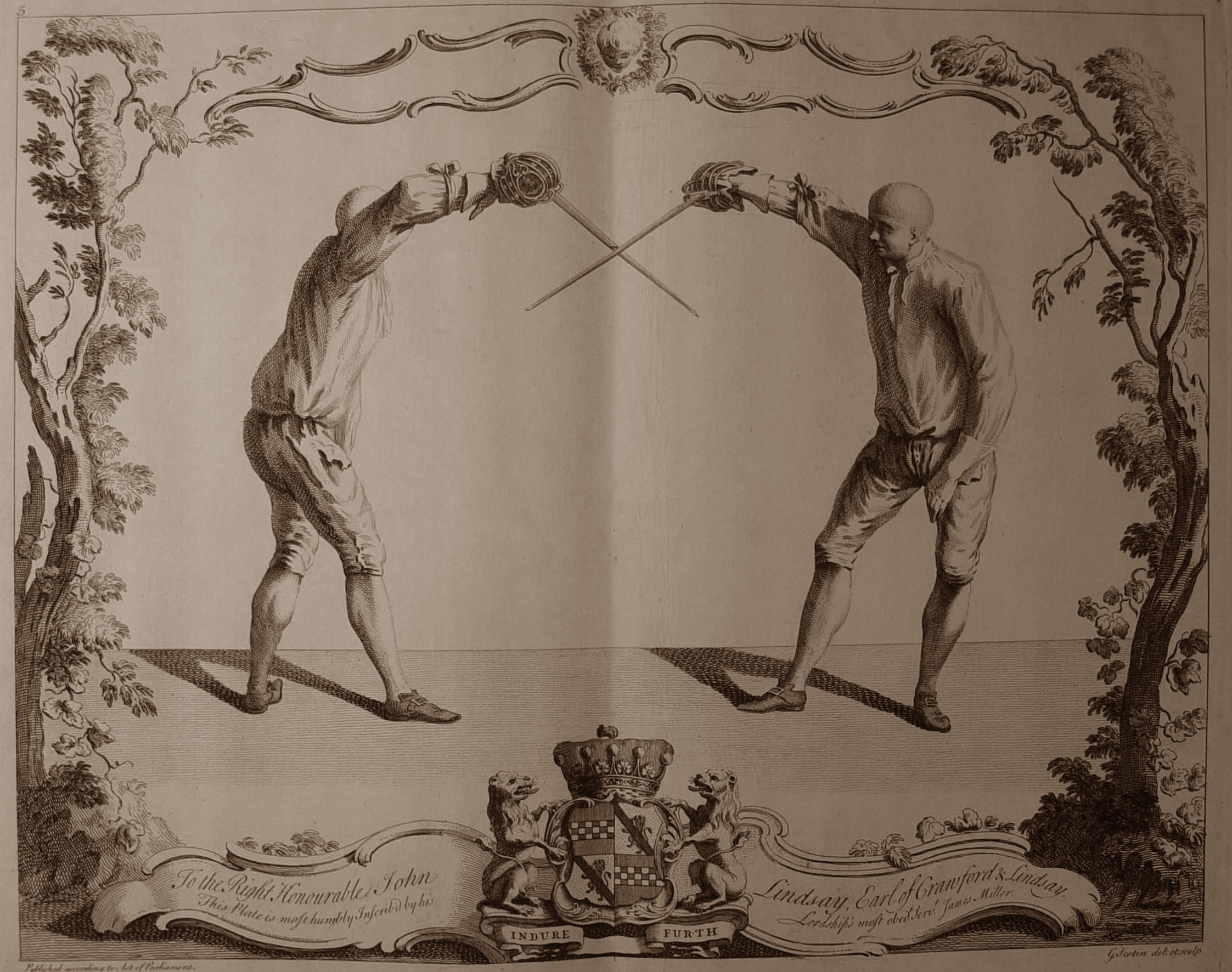
The hanging guard according to Miller. To be used when “press’d very hard, or have more than one to contend with.” This is the guard that Sir Wm. Hope came to favor so much.
A Treatise on Backsword, Sword, Buckler, Sword and Dagger, Sword and Great Gauntlet, Falchon, [&] Quarterstaff by Capt. James Miller, 1738. Plates with a column of descriptive notes on the front page. Half a dozen or more of the fifteen plates apply to the basket-hilt backsword, and two to the falchion, and therefore to the cutlass. Excellent illustrations of positions poorly illustrated or described in other cutting sword texts of the period. Sir Wm. Hope was a fan of the “great gauntlet,” particularly on the battlefield. Miller was a soldier, later a stage gladiator.
The Use of the Broad Sword by Thomas Page. Norwich, England: M. Chase, 1746. 18th century broadsword technique, including that of the Scottish Highlanders, applicable also to the backsword and cutlass.

“The Guards of the Highland Broadsword as taught at Mr. H. Angelo’s academy.” 1799, illustrated by the famous Thomas Rowlandson. British Museum.
Highland Broadsword, edited by Paul Wagner and Mark Rector, 2004 (1790 – 1805). Five late 18th and early 19th century broadsword manuals (Anti-Pugilism by “a Highland Officer,” 1790; MacGregor’s Lecture on the Art of Defence, 1791; On the Use of the Broadsword by Henry Angelo, 1817; The Art of Defence on Foot with the Broad Sword and Saber, by R. K. Porter, 1804; and Fencing Familiarized, by Thomas Mathewson, 1805). Practical cut-and-thrust swordplay.
The Broad Swordsman’s Pocket Companion, “Designed by Capt. Wroughton,” ca. 1830. One of the last real English broadsword manuals of the era of Empire—actually, a book of plates only—before cut and thrust began to be absorbed by the rise in popularity of saber, not that there was actually much difference. Short, well-illustrated with colored prints of military fencers wearing fencing masks and armed with singlesticks. The book is exactly what it says.
The Art of the Dueling Sabre by Settimo del Frate explaining Guiseppe Radaelli’s saber method, translated and explained by Christopher Holzman, 2011. Del Frate’s original works were published in 1868 and 1872. Indispensable, along with the Wright/Masiello/Ciullini work below, for understanding Radaelli’s method of saber. It changed Italian saber fencing forever, and is the root of the Hungarian school.
Lessons in Sabre, Singlestick, Sabre & Bayonet, and Sword Feats; or, How to Use a Cut-And-Thrust Sword by J. M. Waite, 1880. Superb text on practical swordplay, highly recommended.
The Broadsword: as Taught by the Celebrated Italian Masters, Signors Masiello and Ciullini, of Florence, by Francis Vere Wright, Ferdinando Masiello, and [first name unknown] Ciullini, 1889. An English text on the Italian school of the light or dueling saber established by Guiseppe Radaelli in the 1870s. Maestro Masiello was a student of Radaelli; Ciullini probably was as well. Soon this Radaellian school would be transformed by Italo Santelli (a student of Carlo Pessina, who was a student of both Radaelli and Masaniello Parise) and László Borsody into the Hungarian saber school that would lead to Hungary’s half century reign in international sport saber competition. For those interested in the debunking of fencing myths, the book clearly states why the modern saber target is restricted to the area above the waist (and no, it has nothing to do with sabers once having been used on horseback): it was considered “unchivalrous” to hit below the belt. That is, the Italians wanted to keep their manhood undivided.
Cold Steel by Alfred Hutton, 1889, modern reprints available. Practical swordplay for the light saber (sorry, Star Wars fans, it’s not what you think) or even backsword, and also the “great sword” and stick. Highly recommended.
Broadsword and Singlestick by R. C. Allanson-Winn, 1890, reprints 2006, 2009. Excellent work on practical cut-and-thrust swordplay, most highly recommended. Quite English in its pragmatism.
See also Wylde, McBane, Godfrey, and Lonnergan in the Smallsword section above.
Cutlass

Parrying a cutlass cut with a pistol, an experimental technique rather than an established one. Manuscript illustration by Lt. Pringle Green of the HMS Conqueror, early nineteenth century. National Maritime Museum, Greenwich. Lt. Pringle’s discussion of boarding actions and swordplay is not in print but a modern clean pdf is available.
In spite of the popular—and correct—association of the cutlass with piracy, privateering, and naval boarding actions of the 17th through early 19th centuries, there are for all practical purposes no cutlass texts prior to the late 18th. Even Roland (see the Smallsword section above), who recommended fencing in particular for naval officers and crews because they had the most need of it given the prevalence of boarding actions, and Girard and McArthur who were naval officers, do not really describe it—Girard not at all, McArthur only briefly by identifying its guards and cuts as those of broadsword, and Roland largely by quoting McArthur.
Cutlass play, at least as described in cutlass manuals, of the later era was based almost entirely on the broadsword and saber technique of the time. However, given the cutlass’s useful abilities at close distances (those of riposte and of grappling), there were doubtless techniques used in earlier periods but not noted later, for example grazing parry-ripostes made in a near-single tempo, short powerful cleaving cuts, plus a variety of techniques suitable when grappling, not the least of which would have been pummeling. F. C. Grove in the introduction to Fencing (London: Longmans, Green, and Co., 1893) wrote: “One of us once saw a sailor of extraordinary strength seize a cutlass close to the hilt, where the edge is blunt, and break it short off.” Quite unconventional even by 17th century standards, yet for the seaman armed with a cutlass in action, not at all surprising. Marcelli (see the “Rapier” section above) notes something I’ve not seen elsewhere but becomes quite obvious when practicing cuts with a cutlass: the weapon is capable of fatal strokes at grappling distance.
Besides the study of backsword, broadsword, and saber texts, I recommend those of the dusack as well. Practice with a knowledgeable partner is also required, as is cutting practice in order to get a good feel for the weapon. The very few texts below are merely representative of saber technique of the later period: it is by no means a complete list. I have described late 17th century cutlass technique, or at least what we know of it, in The Sea Rover’s Practice, The Buccaneer’s Realm, and The Golden Age of Piracy, especially in the last book. Additionally, those interested may want to review my blog post, Buccaneer Cutlasses: What We Know, as it includes some information on technique. Marcelli and Girard have some discussion of opposing a saber against a rapier or smallsword, and Marcelli also vice versa, much of which is applicable to the cutlass. Likewise Captain Miller in the “Backsword” section has two plates showing falchion or hanger guards (inside and outside) applicable to the cutlass.
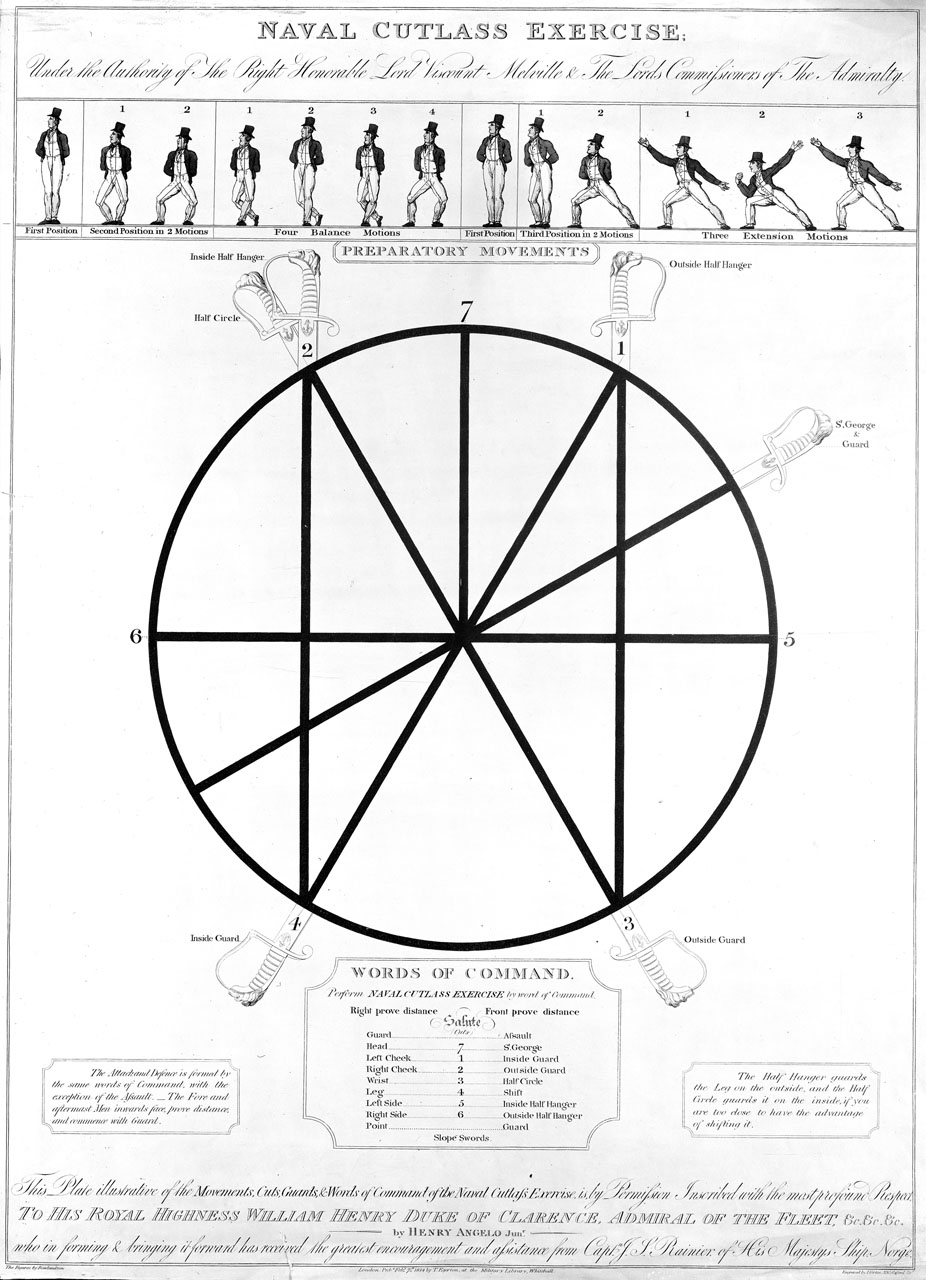
Naval Cutlass Exercise by Henry Angelo, 1813. A detailed illustration of footwork, cuts, and “words of command.” Based entirely on the broadsword, it might as well be broadsword, so why bother—except that Angelo was paid for it by the Royal Navy. In his defense, McArthur (see the “Smallsword” section above) agrees that cutlass and hanger guards and cuts are the same as those of the broadsword. Nonetheless, there are techniques one can use with a cutlass at the distance of “handy-grips” that cannot be used with a broadsword or other longer cutting sword.
Naval Cutlass Exercise “For the Use of Her Majesty’s Ships,” 1859. Includes a good general illustration of cuts and guards, as well as well-regulated military-style (naturally) drills for cuts, guards (equivalent to parries), and points (thrusts, that is). The brief “Concluding Observations” include a vital one for combat: “…but he must ever be “on guard” to meet the impromtu [sic] hit of such as cannot help returning [riposting], whether hit or not.”
The Ship and Gun Drills of the U. S. Navy, by the Naval Department, Division of Militia Affairs, 1914. Seaman’s manual with brief instruction on the USN “Sword Exercise.” The attacks and parries are simple and functional, and the illustrations useful.
British Naval Swords and Swordsmanship by John McGrath & Mark Burton, 2013. Includes a couple of good chapters on British naval swordsmanship, but as can be expected given the source material, the discussion is by and large of the late 18th century and afterward. Includes a description of British naval fencers as well. Required background reading for the student of cutlass swordplay and required technical reading for the collector of British naval swords.
Bibliography
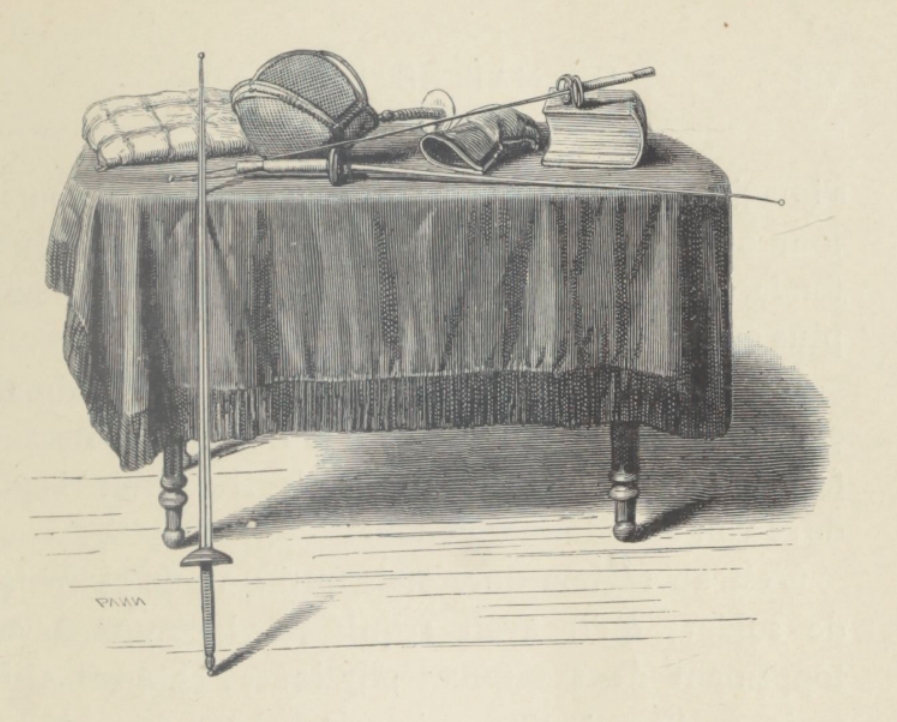
The intersection of study and practice in fencing. From Vigeant, not his bibliography but his biography of famous fencing master Jean-Louis (see the “Smallsword” section above).
La Bibliographie de l’Escrime Ancienne et Moderne by Arsène Vigeant, 1882. Not as complete as the bibliography below, but highly useful nonetheless. M. Vigeant had a thorough understanding of both swordplay itself and its history.
A Complete Bibliography of Fencing & Duelling by Carl A. Thimm, 1896. A very useful, largely complete bibliography through the late 19th century. Reprints from 1968 and 1999 are available, though often pricey. Look instead for the free pdf on Google books unless you find that fortune generally favors you or you have plenty of money to spend, the latter, of course, being one way or another proof that fortune has favored you at least once.
The History of Fencing & Swordplay
Schools and Masters of Fence by Egerton Castle, 1885, reprints 1968, 2003. European fencing to the late 19th century. Highly recommended.
Old Sword Play by Alfred Hutton, 1892, reprint 2001. A brief description of European fencing technique over the ages by a noted English fencing master.
The Sword and the Centuries by Alfred Hutton, 1901, reprint 1995. A history of European fencing and swords.
IIIe Congrès International d’Escrime, Brussels, 1905. For those interested in the arguments and squabbles that created modern sport fencing rules—and how sport interests came to dominate in epee competition, rather than having epee competition emulate dueling or the jeu de terrain as closely as possible.
The English Master of Arms: From the Twelfth to the Twentieth Century by J. D. Aylward, 1956. Excellent work covering not only English fencing masters, but necessarily the development of fencing in the British Isles as well. One of my favorites. Aylward’s book on the smallsword in England is also highly recommended for anyone with an interest in smallswords or late seventeenth and eighteenth century fencing or dueling.
Swordsmen of the Screen: From Douglas Fairbanks to Michael York by Jeffrey Richards, 1977. The history of swordsmen and swordswomen in film to 1977. Swashbuckling actors and the fencing masters who doubled for them. Worth the read if you’re into film swashbucklers.
Martini A-Z of Fencing by E.D. Morton, 1988. Not a book on fencing history per se, but a compendium that includes much fencing history, as well as fencing terms, concepts, and trivia. One of Mr. Morton’s entries is Rafael Sabatini. I disagree with most of Mr. Morton’s criticisms of Sabatini, including his claim that much of what he wrote about ships &c is in error. Sabatini did make errors, but they’re not nearly so egregious as Mr. Morton claims, with the exception of presenting a ship’s stern to cannon-fire in order to minimize damage (in fact, this would, as Mr. Morton notes, be more dangerous). Vanity aside, I hesitate to note that I am in fact an expert in this area, and can easily point out where Mr. Morton is incorrect. Notwithstanding that the majority of Mr. Morton’s entries are valid, readers must take the Sabatini entry with a grain of salt.
En garde: Du duel à l’escrime by Pierre Lacaze, 1991. Well-illustrated popular history of mostly French fencing and swordplay.
The History of Fencing by William M. Gaugler, 1998. A detailed history and analysis of the Italian schools into the first half of the 20th century, with a fair, if quite limited, discussion of French schools. The modern schools, including the revolutionary Hungarian (or Hungarian-Italian) saber school, are unfortunately not described.
Escrime by Gerard Six, photography by Vincent Lyky, 1998. “Coffee table” fencing book covering everything from history to technique, albeit briefly, and mostly French. Well-photographed.
The Secret History of the Sword by Christoph Amberger, 1999. By a veteran of the Mensur, also known as fighting for scars—which is by most definitions the purpose of macho male one-ups-man-ship. Most of us, just like Tom Sawyer, are proud of our scars. Highly recommended—the book that is, but we can include scars as well, as proof of a life well-lived and of a fortunate one also, in that we’re still alive to show off our scars.
Croiser le Fer: Violence et Culture de L’épée dans la France Modern (XVIe-XVIIIe Siècle) by Pascal Brioist, Hervé Drévillon, and Pierre Serna, 2002. Excellent scholarly study of swordplay and dueling in France from the 16th to 18th centuries. Highly recommended.
By the Sword by Richard Cohen, 2002. A history of fencing, including the modern schools, by a British Olympic fencer. Arguably the only thorough modern history of fencing. Highly recommended.
Reclaiming the Blade by Galatia Films, DVD, 2009. A mostly well-intentioned attempt to “reclaim” authentic Western swordplay and historical fencing, but unfortunately marred by the heavy-handed, ideological manner in which it attacks sport fencing and some other forms of swordplay, not to mention by its egregious overuse of Hollywood references and interviews—Hollywood depictions of swordplay are usually divorced entirely from reality, thereby undercutting the argument. At its best, the documentary extols Western swordplay. At its worst, it further divides rather than unites the several major fencing communities.
To pick a bone with—or perhaps cross swords with?—the film’s makers, although many modern competitive fencers often do not practice the ideal of “hitting and not getting hit,” there are plenty, epeeists especially, or at least veteran epeeists, who do understand the concept well, can execute it exceptionally well when necessary, and are happy to argue the point, weapon in hand, with any fencer of any sort. In fact, some of us trained entirely under masters who fenced when dueling was still practiced and the saber was still a military arm—and who understood that it was entirely acceptable to practice both forms of swordplay, that is, sport or recreational, and practical training for combat with real weapons. To promote the so-called reality of historical and classical fencing is double-edged and often cuts hypocritically: excessive “contre-temps” or double-touches have been the bane of fencing for centuries, and modern “historical” and “classical” fencers are no more immune to them than were the fencers of the past whom they seek to emulate.
Japanese Texts
Tengu Geijutsuron (The Demon’s Sermon on the Martial Arts) by Issai Chozanshi [Niwa Jurozaemon Tadaaki], translated by William Scott Wilson, 2006. Includes the famous story illustrating the psychology of swordplay, Neko no Myojutsu (The Mysterious Technique of the Cat). Originally written in the early 18th century.
Heihō Kaden Sho (The Sword and the Mind) by Kamiizumi Hidetsuna, Yagyū Muneyoshi, and Yagyū Munenori, translated by Hiroaki Sato, 1985. Originally compiled in the 17th century.
Go Rin No Sho (A Book of Five Rings) by Miyamoto Musashi, translated by Victor Harris, 1974. Completed in 1645, shortly before the author’s death. Numerous editions available, including an excellent translation by William Scott Wilson. A classic on swordplay, strategy, and tactics.
The Unfettered Mind by Takuan Sōhō, translated by William Scott Wilson, 1986. Three essays on swordsmanship (Fudōchishinmyōroku, Reirōshū, and Taiaki) by a Zen master and contemporary of Musashi. Written in the early 17th century.
Suggestions on Acquiring the Books Above
Several of the listed titles (Borysiuk, Czajkowski, Harmenberg, Holzman, Kogler, Lukovich, Szabo, and Vass) were available directly from the publisher, Swordplay Books Online (http://www.swordplaybooks.com/), but with the passing of its owner/editor the titles are largely available now only from fencing suppliers while their stock lasts, and from other common sources. Many fencing books in print may be ordered from various online retailers, and occasionally may be found in bookstores. However, most of the titles listed above are out of print. Some of the older titles are in the public domain and are available as .pdf files on Google Books, archive.org (an excellent site but for its terrible practice of making some books still under copyright available, thus cheating their authors and publishers), and other electronic book sites. College students and faculty may be able to access some titles digitally or in traditional print via their university libraries.
Some of the seventeenth and eighteenth century titles in English are published as fairly inexpensive reprints by Gale ECCO and EEBO (Early English Books Online), along with similar cheap—in the sense of cheaply reproduced from mediocre quality digital scans or old microfiches—facsimile reprint publishers, and are available via Amazon and other online bookstores. However, please note that most of these versions DO NOT INCLUDE FOLDOUT PLATES thanks to Google and other publishers’ “get them copied as fast as possible” practice, so if you’re looking for the illustrations you may have to look elsewhere. Some of these and other old fencing texts may be found in various national digital libraries, often of much better quality, and with complete foldout plates.
A reader of this post, Pradana (see Cruzado y Peralta in the rapier section above), recommends Freelance Academy Press https://www.freelanceacademypress.com/, Fallen Rook Publishing http://www.fallenrookpublishing.co.uk/publications/, and AGEA Editora http://ageaeditora.com/en/ as sources for modern reprints.
Bookfinder.com compares prices of books in and out of print among online retailers, including independent booksellers. Fetchbook.info compares prices among online retailers and some of the major independent bookstores, but appears to be down at the moment, permanently perhaps. Abebooks.com and Alibris.com permit title searches through the stock of thousands of independent booksellers; I personally recommend Abebooks although some “drop shipment” booksellers–at times unreliable in their descriptions–now are among the sellers since Amazon (unfortunately) purchased the site. Search all of these sites to get an idea of price range before searching on eBay: although some books on eBay are good, even great, deals, some are grossly overpriced or over-bid.
My general preference is for Abebooks.com if you don’t have a local independent brick-and-mortar store carrying fencing books (unlikely). Those of you who never had to rely twenty-five or more years ago on book vendors for online searches won’t quite appreciate how useful and cost-effective Abebooks &c. are: “back in the day,” booksellers doing searches for customers would typically mark up the price of a book found at another vendor by one hundred percent—plus shipping. Naturally, they didn’t inform you of this practice.
Some fencing books can be found on Amazon.com, but ALWAYS price compare first, especially with used or antiquarian editions. Many Amazon book vendors have a bad — frankly, unethical — practice of listing out of print volumes at ridiculously high prices. About nine out of ten I’d say. I’ve seen a used copy of one of my books listed for about $300 by an Amazon vendor, when it could be found on other sites for as little as $25 in the same condition. Similarly with fencing books. Two more reasons to avoid Amazon: the company often packs books, softcovers especially, with other items, leading to damaged books. A call to Amazon customer service about this resulted only hilarious escalation from representative to supervisor to “specialist” with no solution other than a promise to “forward your [my] concerns to the appropriate team.” Their scripts don’t cover the issue other than to offer a refund after the book is returned. I didn’t want a replacement: I wanted Amazon to stop damaging books. This request perplexed them immensely, for their was no answer to it in their scripts. Last, Amazon’s cutthroat pricing on books, in which the company apparently loses money, is designed to corner your book sales market at the expense of local bookshops and major chains. I’d rather support bookstores than a rapacious enterprise.
Many fencing suppliers carry fencing books in stock, although the number of titles may be limited. Some libraries carry fencing books, but the selection these days is usually slim. Compare to my high school library which had three or four books on fencing, and we didn’t have, and never had, a fencing club or team.
Most of the sport fencing books listed above are dated in regard to modern competitive rules, practices, and uniform and equipment requirements. Always refer to the current USA Fencing rule book and USA Fencing operations manual, or other appropriate national fencing regulations for HEMA, historical, classical, and other organizations, for competition rules and regulations. USA Fencing rules, such as they now are, are available for download at USA Fencing’s website.
Copyright 2008-2022 Benerson Little. Last updated October 7, 2022.













[…] discussed training in the cutlass elsewhere, including a few notes in my Fencing Books For Swordsmen & Swordswomen post. In Sea Rover’s Practice I note that there was clearly some instruction at sea, although […]
LikeLike
Thank you for that extensive list. Even if I resd the Engilsh texts I would be kept busy for years. Enjoyable years of course.
LikeLike
You’re welcome! I’m slowly adding more images, and, as I study them, more books. I’ve been at this for forty years and still have much to learn–and I’ve never been bored with the study!
LikeLike
Unfortunately, Cruzado y Peralta is the exact opposite of your description of him here — his work is a polemic on the flaws and weaknesses of the so-called “common” or “vulgar” fencing in contrast to the Verdadeira Destreza school, which he favoured. A far better source for Iberian “common” fencing is Domingo Luis Godinho, who seemed to have been working to preserve his “common” tradition against officially-backed persecution by the Destreza crowd. As for the Destreza itself, its popular image of unnecessary complexity is heavily coloured by most modern fencers’ unfamiliarity with it. In actual practice (at least according to better modern reconstructions such as those by Puck and Mary Curtis or by Tim Rivera) it’s not more inherently complicated than modern fencing theory, just more difficult to express in words without resorting to physical practice.
LikeLike
I’ll review and correct my description of Cruzado y Peralta. When I reviewed the book, not only is my Spanish fairly weak but I was scanning primarily for details on conventional technique. I’ll also add the Godinho title as you suggest after I review it sufficiently to write a summary (might be a few weeks). I’m aware of the book’s existence but haven’t had a chance to look through it (and a great many others as well). As for Destreza, I don’t have an issue with its technique per se, but rather with the manner in which it was (and apparently often still is) theorized and taught. I consider this “floral” and “philosophical” manner to be an excess which, as I’ve noted, was probably seductive to students and lucrative for masters but unnecessary to teach or learn it. Thanks for your comments!
LikeLike
I don’t know whether you read Spanish and Portuguese or not — if you do, you should be able to handle Godinho just fine with the aid of your favourite means of stress relief to handle his bizarre Portuspanish mishmash language. If not, though, I’d recommend the recently-published full English translation from Freelance Academy Press.
And I don’t entirely disagree about the unnecessarily flowery language in most of the Destreza books. A great deal of it _does_ seem to be aesthetic padding that distracts the student from the elegant simplicity of the system’s practical core. Of course the system itself requires a rudimentary understanding of the Aristotelian physics that dominated European science before Newton came along, but there’s not much abstract philosophy involved beyond that.
LikeLike
I’ve been doing some basic Portuguese translation of a few paragraphs of some 17th century texts recently. Of course, inevitably I consult my wife, she speaks Spanish well, and together we’ve worked through some old Italian and Portuguese texts in addition to Spanish. Never hurts to have a couple of Romance languages under the belt (French and Latin in my case) to aid in learning to read the rest. As for the “accessories” I consider unnecessary to Destreza (or to any form of fencing for that matter), I’m doubtless biased to some degree by some modern masters I’ve known who wrap swordplay (Olympic, classical, historical, &c) up in all sorts of nonsense designed to lure students in for the purpose of business or the cult of personality (ego stroking), or both. Too often this attitude, while it may temporarily serve the teacher’s wallet and ego, eventually turns off most students, although some inevitably remain true believers.
LikeLike
Much of the confusion might be due to Cruzado y Peralta’s rather counter-intuitive titling. I’d render it crudely as “The treatises of common/vulgar fencing with the single sword and arms double, which were reproached by Don Luis Pacheco y Narvaez, and the rebuttals of the True Art and Science against them.” It’s kind of easy to see why this complicated structure can mislead people who just skim the title into thinking that the book is about the merits of “common” fencing because a good editor today would have eviscerated that title and made sure that the really important part stood out in front.
LikeLike
I literally read the title and then scanned for descriptions of common practice, nothing more.
LikeLike
If you’re in the mood for an update, Cruzado has been translated by Tim Rivera: https://www.spanishsword.org/files/techniques.of.the.vulgar.and.common.fencing.translation.pdf
It turns out that the treatise contains short descriptions of the vulgar techniques after all, but basically just as brief introductions to more extensive discussions on how to defeat those techniques according to the principles of the “true” Destreza
LikeLike
Thanks! I’ve just followed your link and downloaded it. Of course, I’m still likely to prefer Quevedo over Narváez. 🙂
LikeLike
Also, I hope you and yours are keeping safe!
LikeLike
Post Script: Do you mind if I mention you by name and link to your blog when I make the correction to Cruzado y Peralta?
LikeLike
Not at all. My blog doesn’t really have much in the way of useful fencing content, though….
LikeLike
Book summary updated, cited you with link. 🙂
LikeLike
If you’re trying to focus on pirate/buccaneer and naval cutlass fencing, it might also be a good idea to take the German Messer/Dussack tradition into account. The most accessible Renaissance and early modern sources would be Joachim Meyer (especially his last 1570 treatise) and Jakob Sutor. Some of their influences can still be seen in German cut-fencing (Hiebfechten) as late as the early 20th century. North Sea and Baltic sailors who had any training in fencing might conceivably have had some contact with these traditions.
LikeLike
I’ve looked at and played with Meyer and the dussack, and even suggested in Sea Rover’s Practice that at least some cutlass play may have resembled it. As soon as you come to “close quarters” or “handy grips” distance with a cutlass, a lot of technique similar if not outright identical to dussack comes quite naturally. This is an area most modern historical fencers of the cutlass don’t seem to have looked into in detail. It’s been a while since I read Meyer and Sutor. Like a lot of texts, I find I need to reread them every few years to recall what I’ve forgotten. The list of re-reading is a long one… There’s an old adage that in fencing (as in everything) the first things you forget are the most important ones.
LikeLike
And while we’re at it, there are several publishers that have particularly good selections of historical fencing manuals. I’d add recommendations for Freelance Academy Press ( https://www.freelanceacademypress.com/ ), Fallen Rook Publishing ( http://www.fallenrookpublishing.co.uk/publications/ ), and AGEA Editora ( http://ageaeditora.com/en/ ) for a start.
LikeLike
I’ll add them to the “how to acquire” section. Most 1880 and later titles I’ve managed to acquire in the original print books, but have had to view earlier copies in pdf, at libraries, or in modern print on demand facsimile reprints (often of poor quality).
LikeLike
[…] ability. If you’d rather begin first by reading about swordplay, you can start here with Fencing Books For Swordsmen & Swordswomen. And if you’re interested in how swashbuckling novels come to be–romance, swordplay, […]
LikeLike
[…] A long detailed list of fencing books can be found here. […]
LikeLike